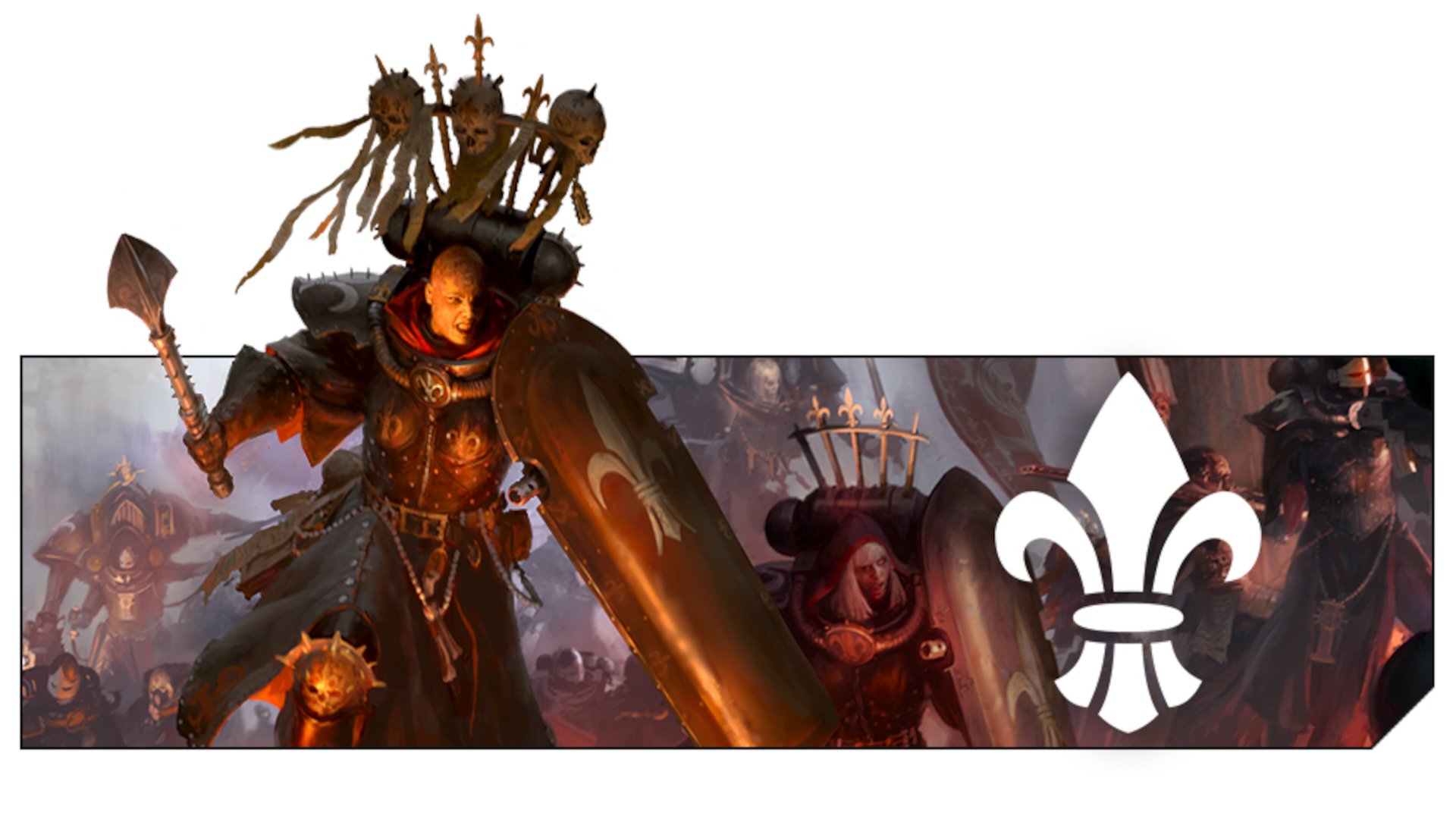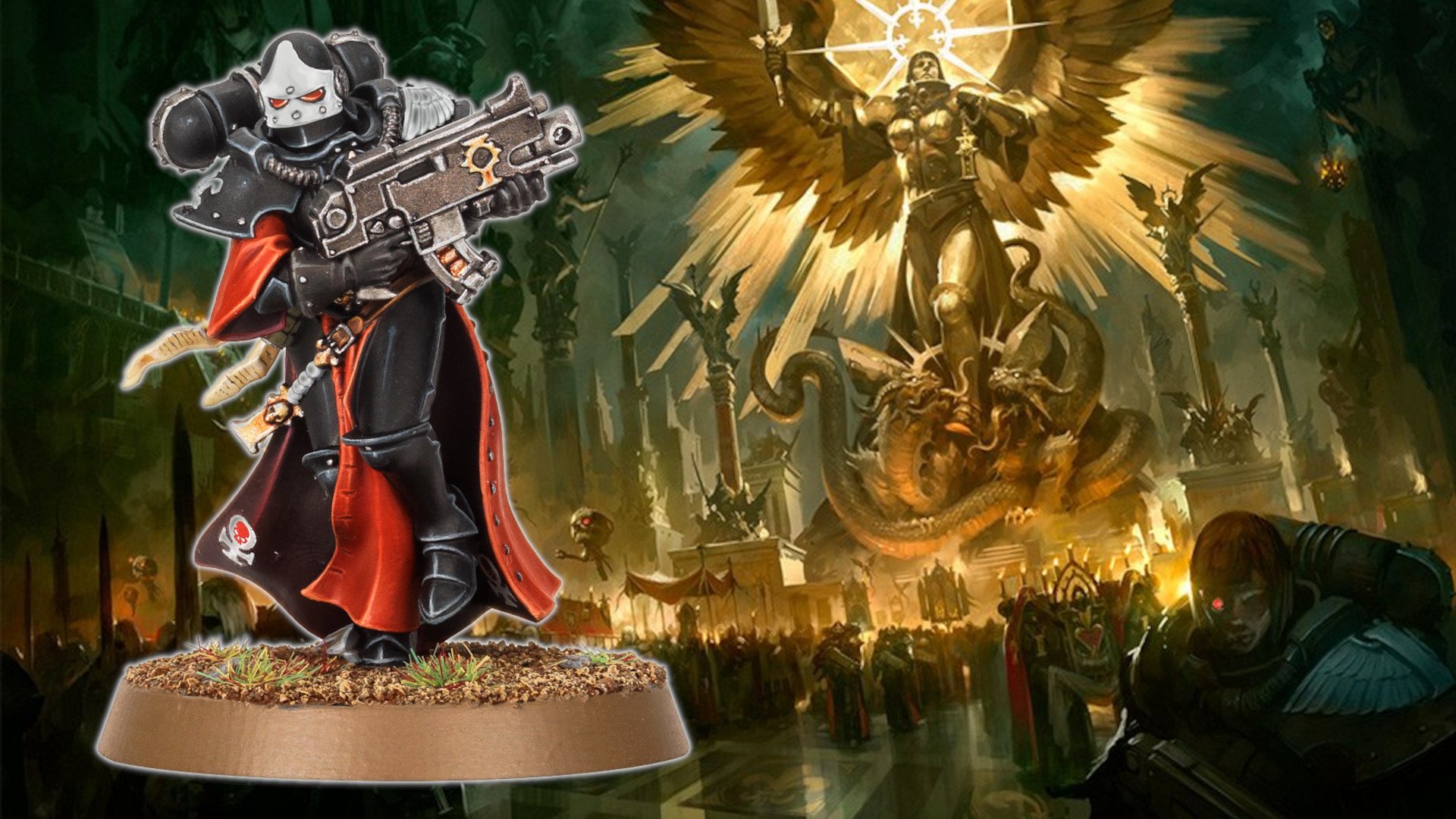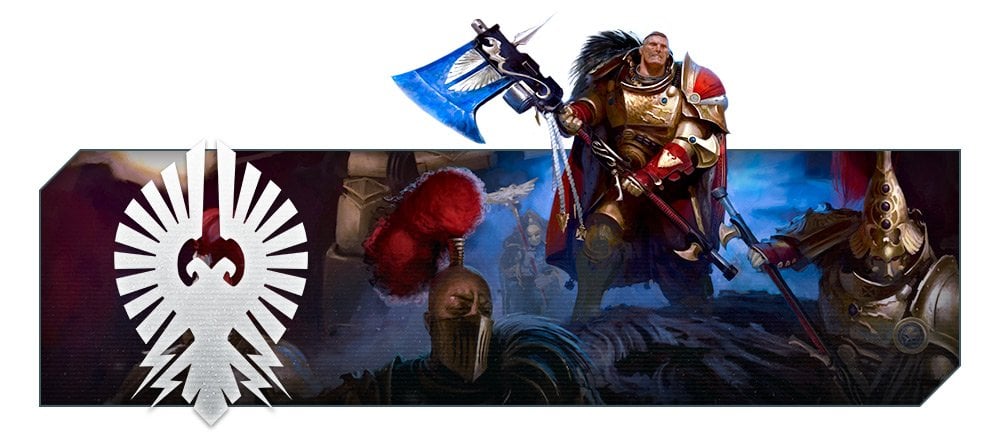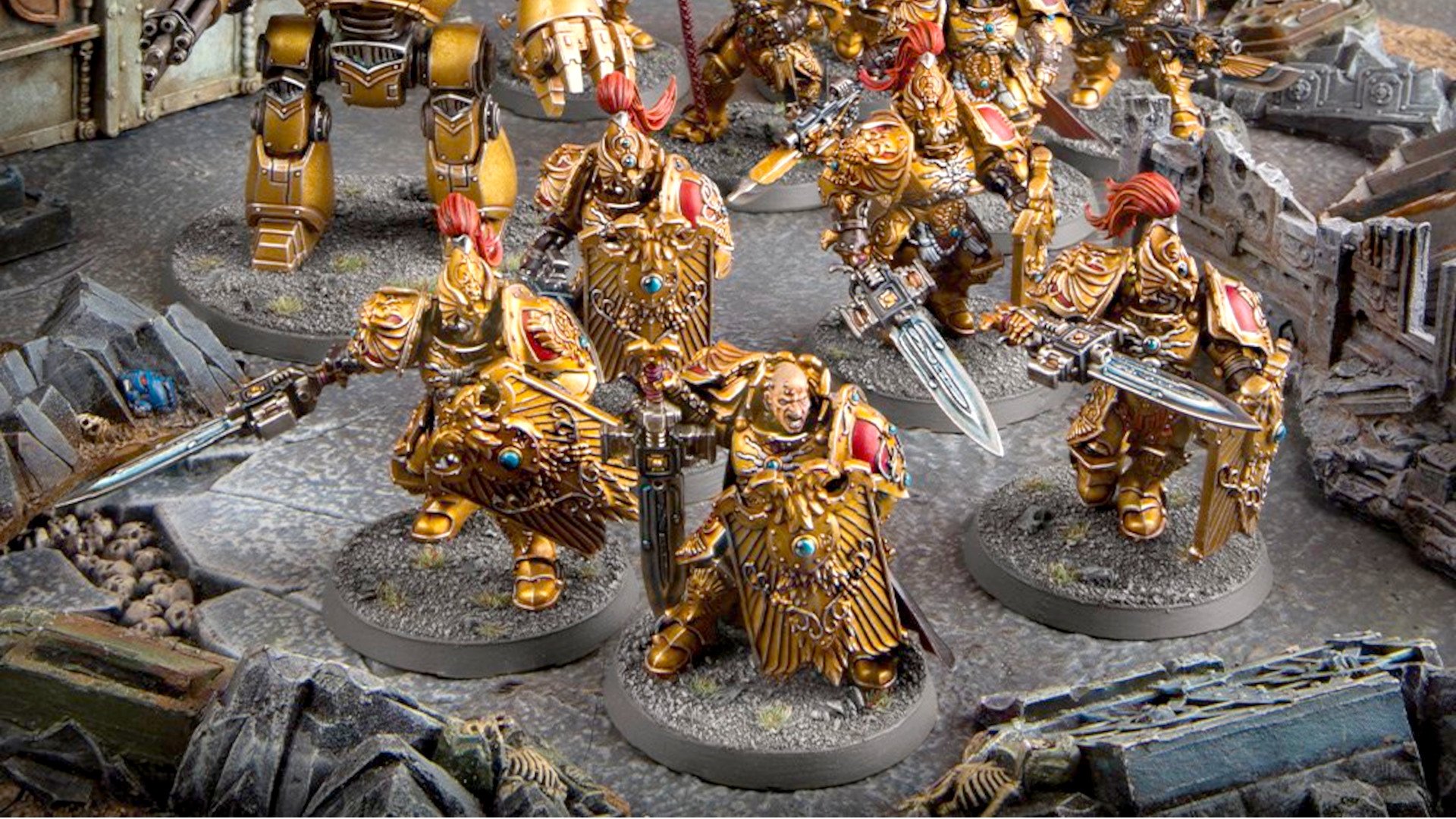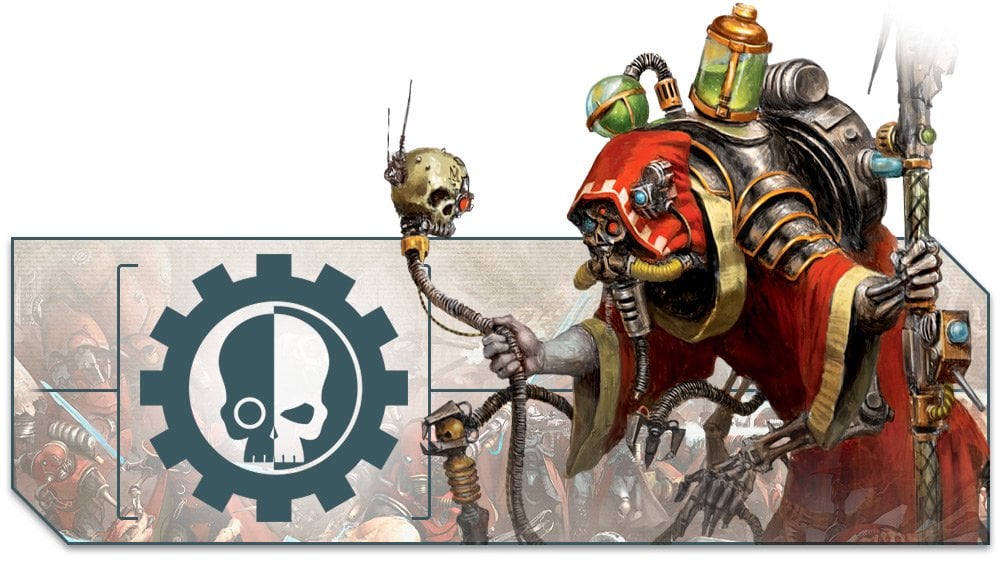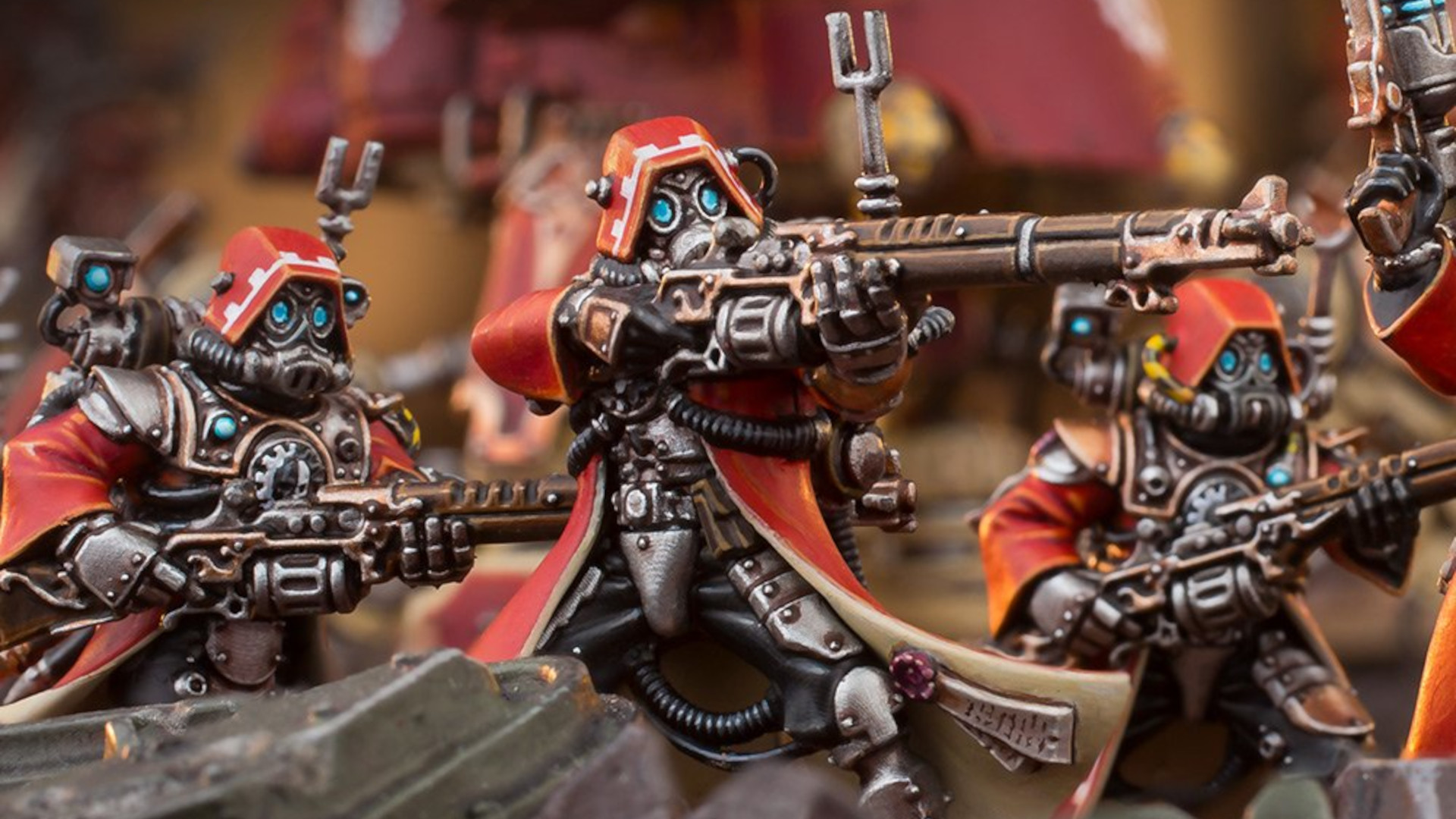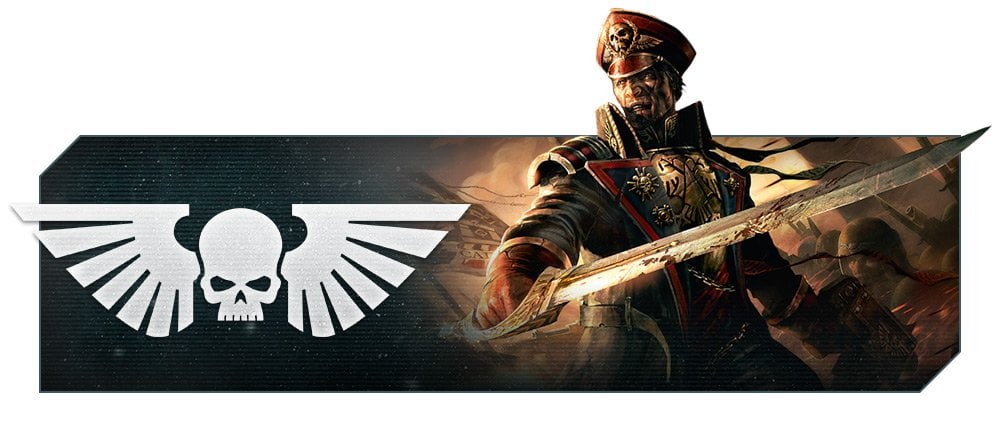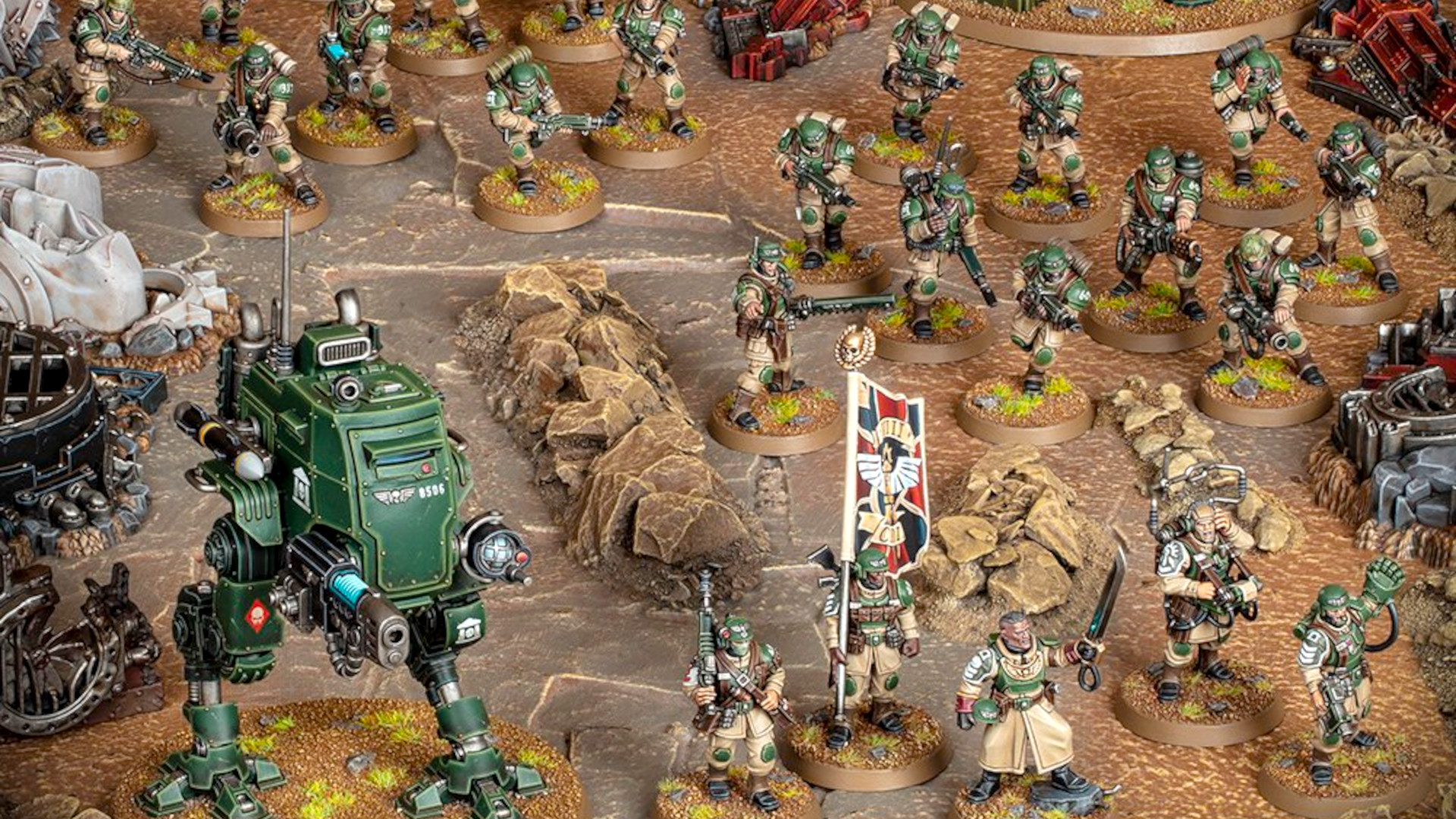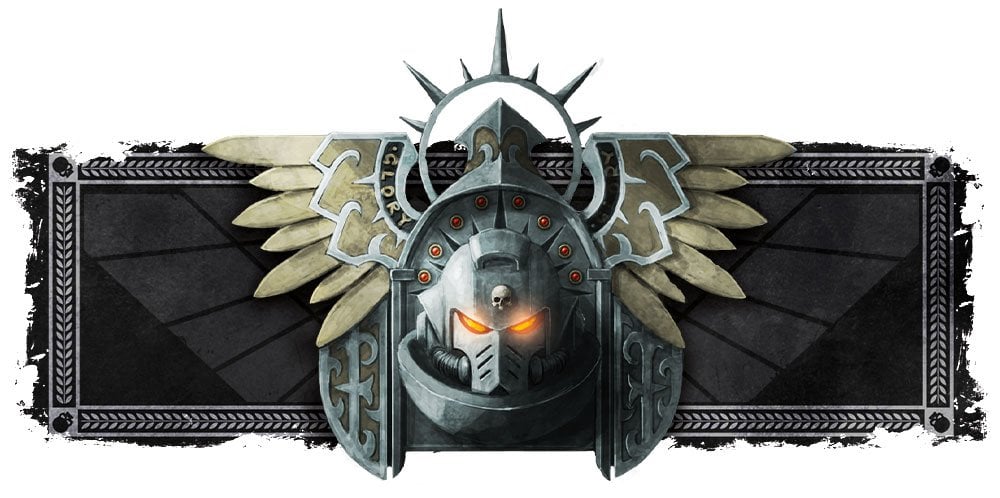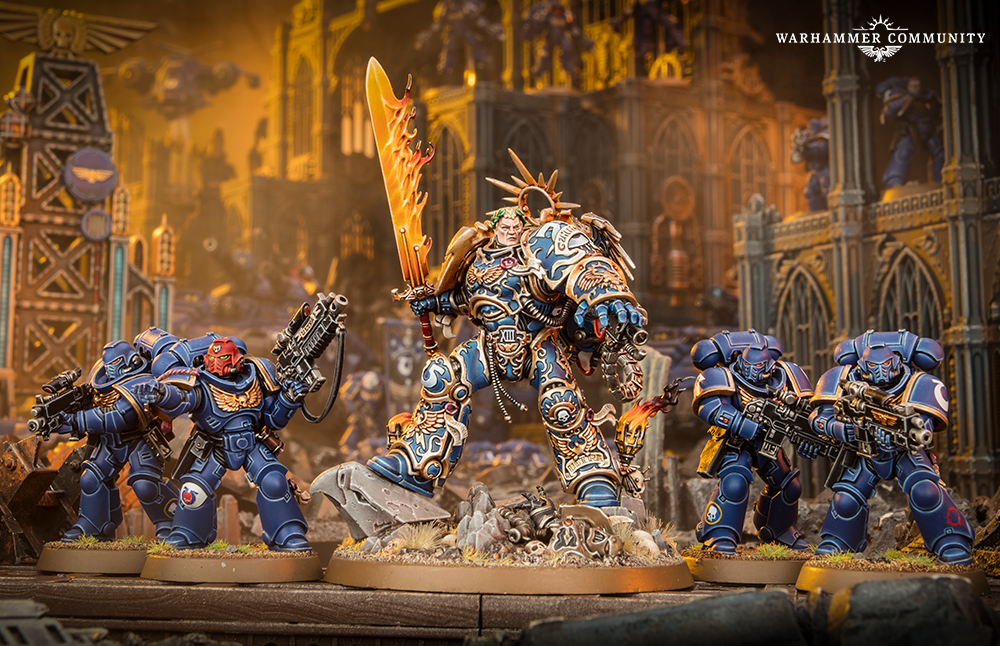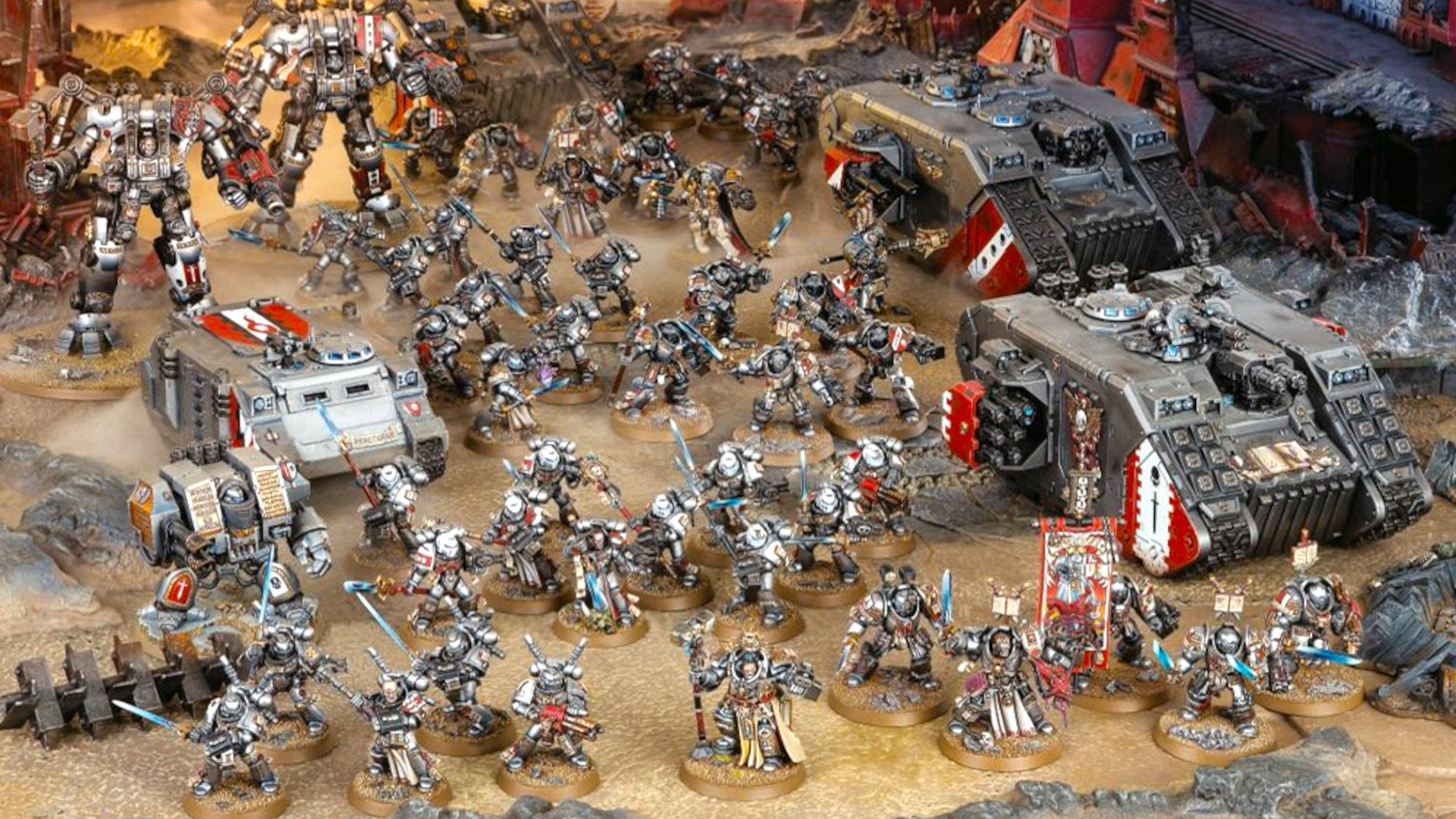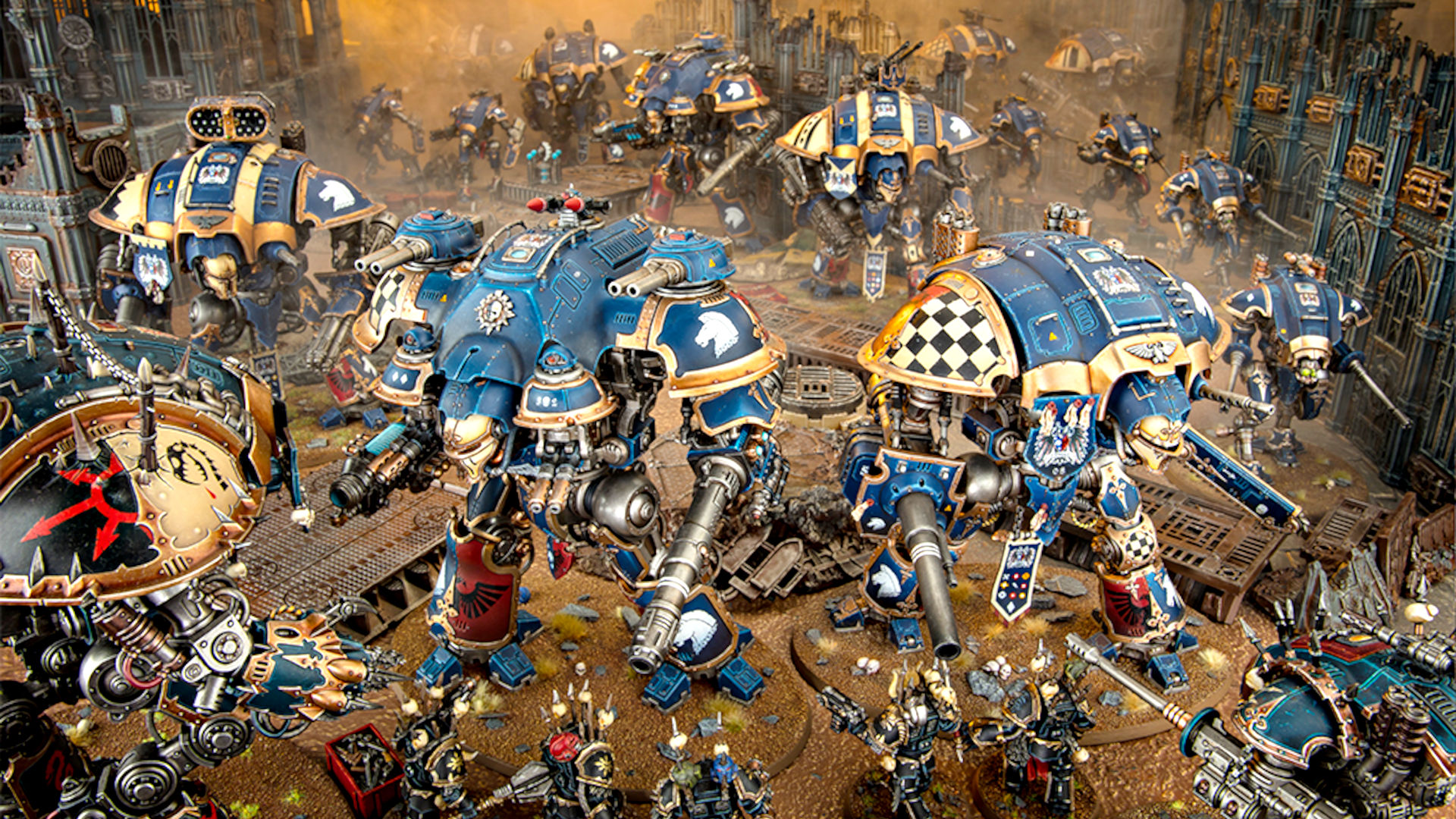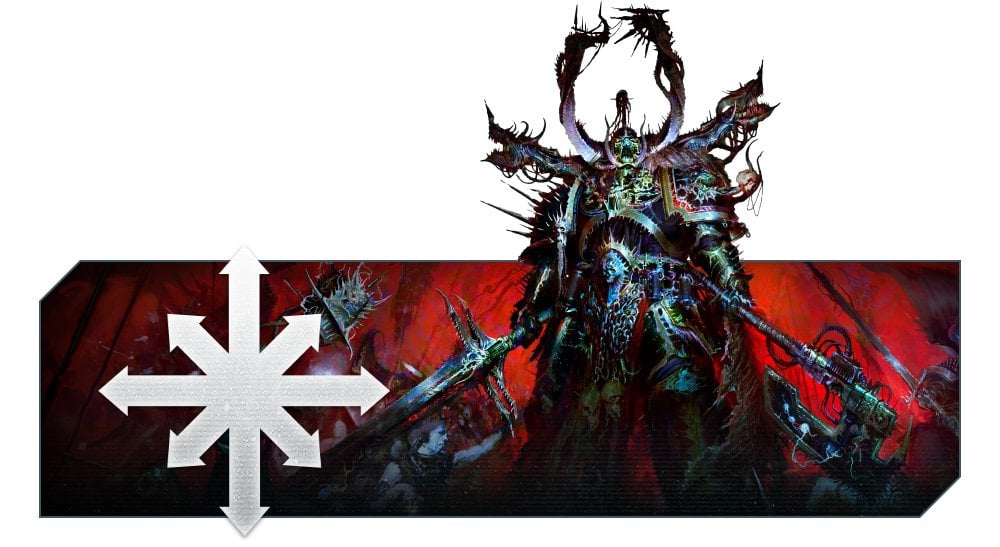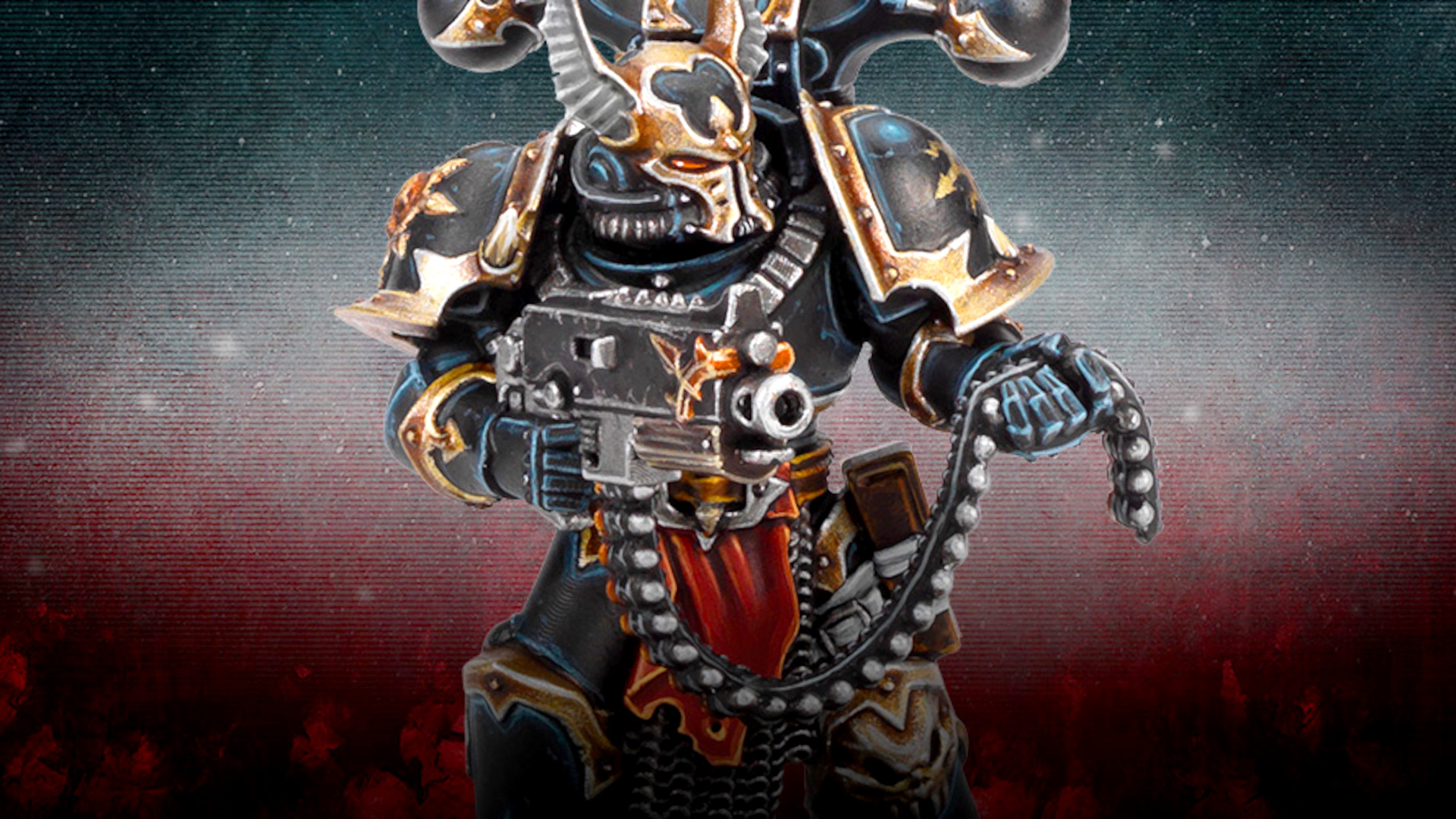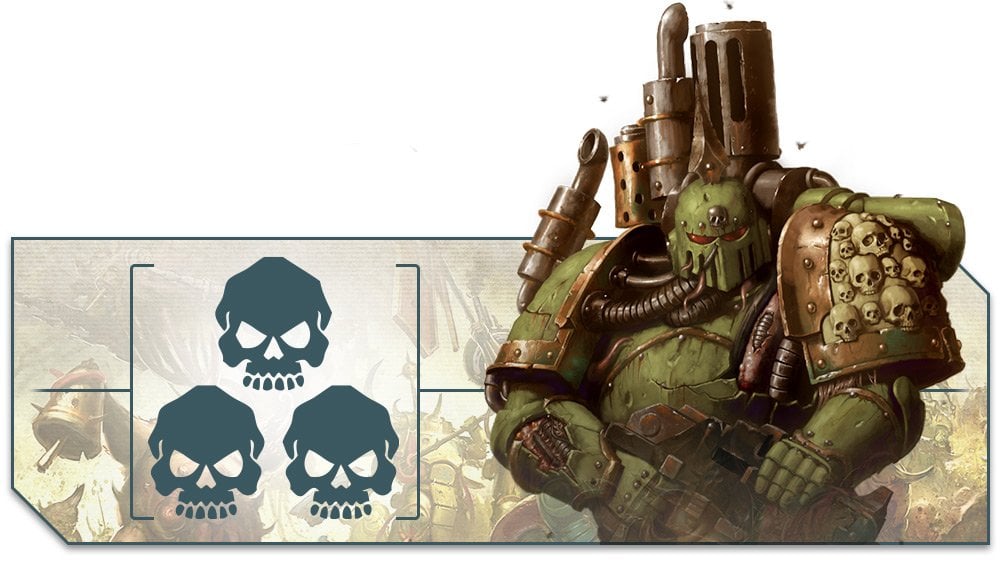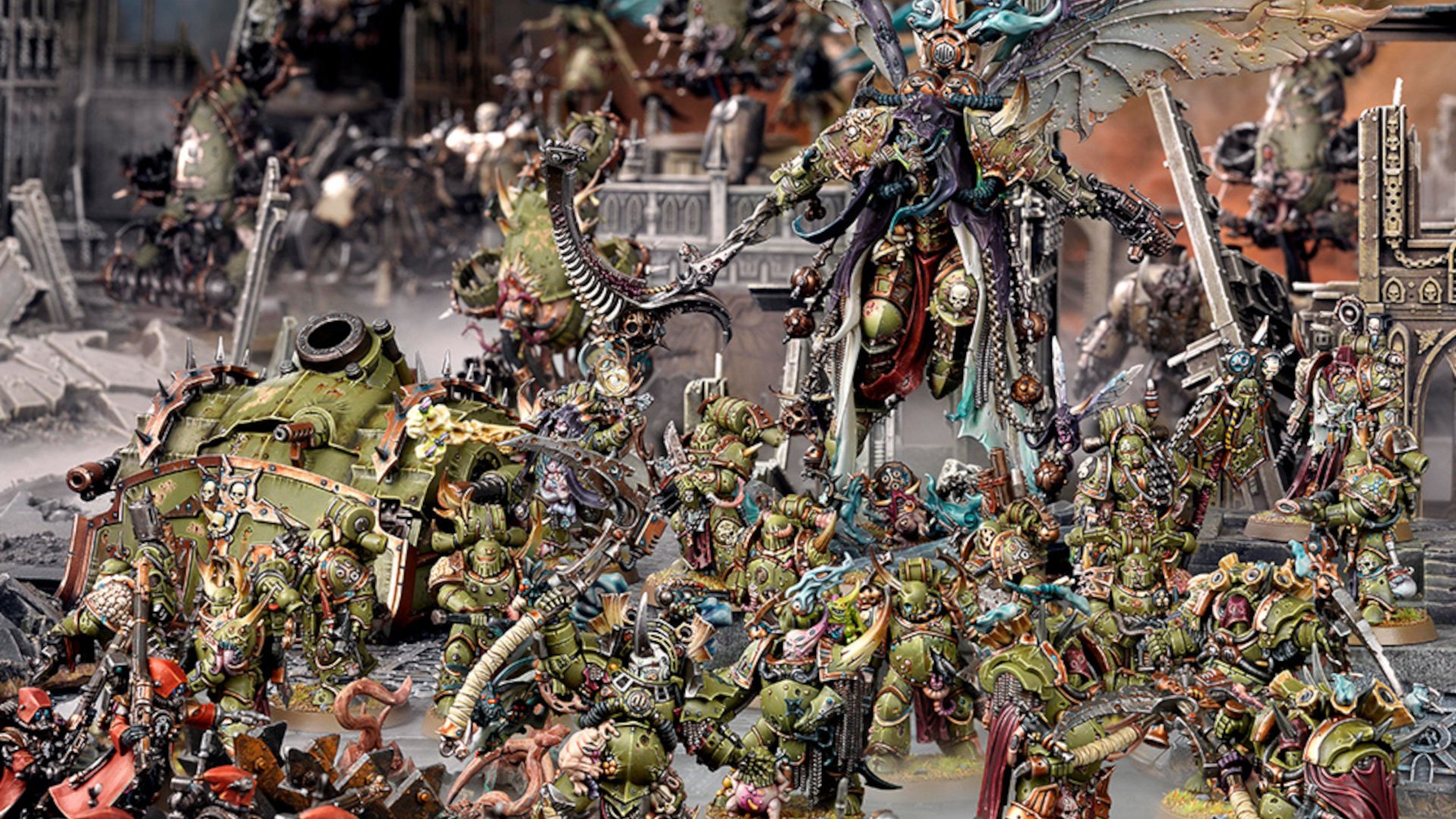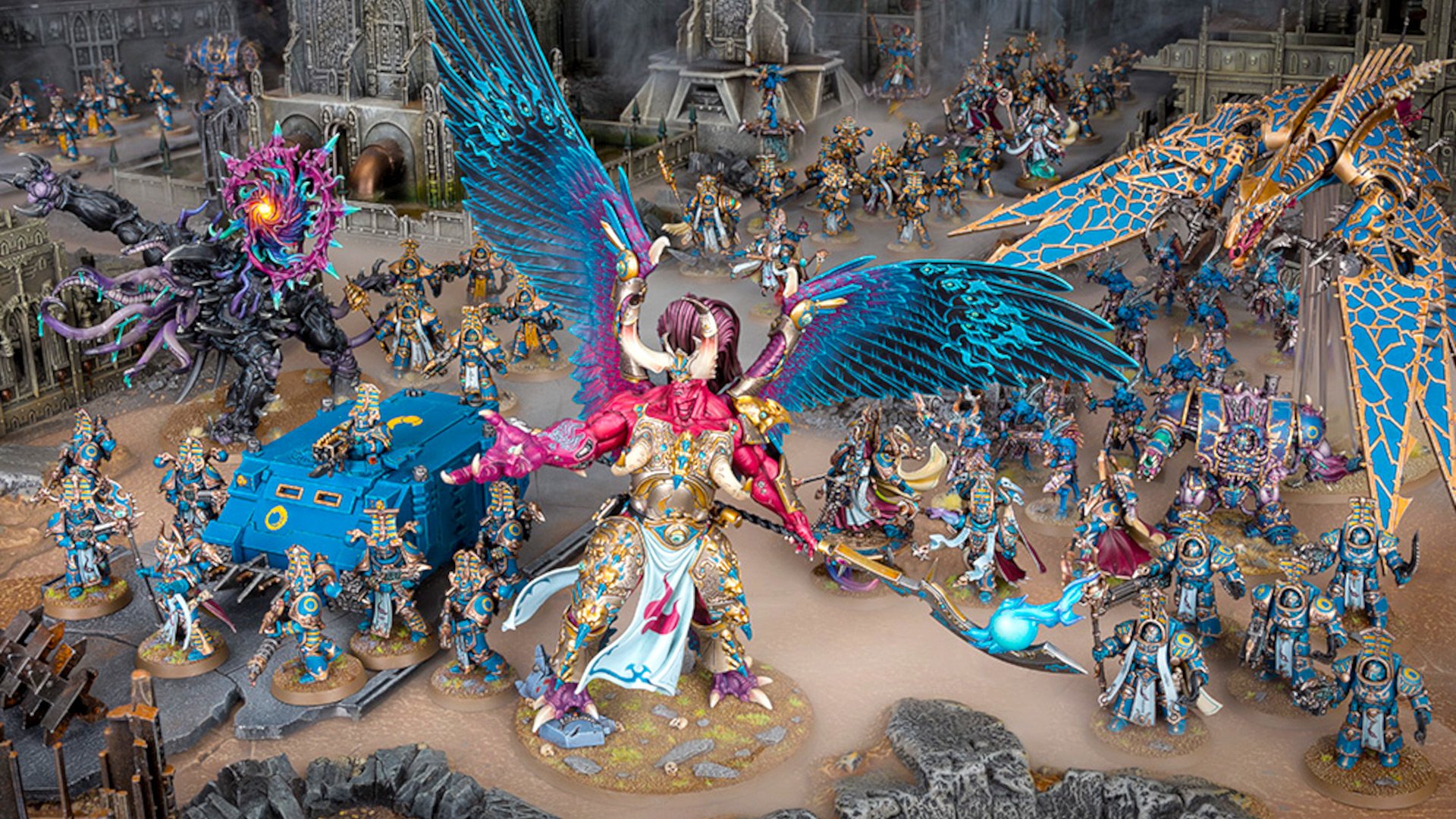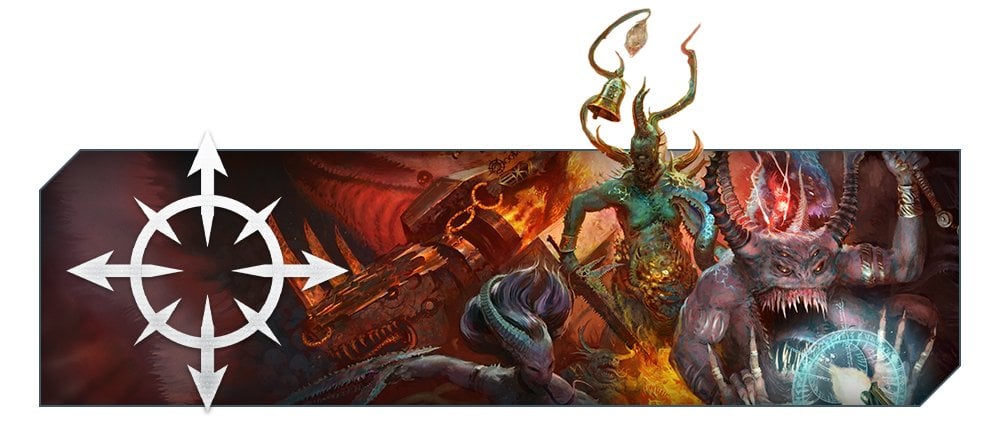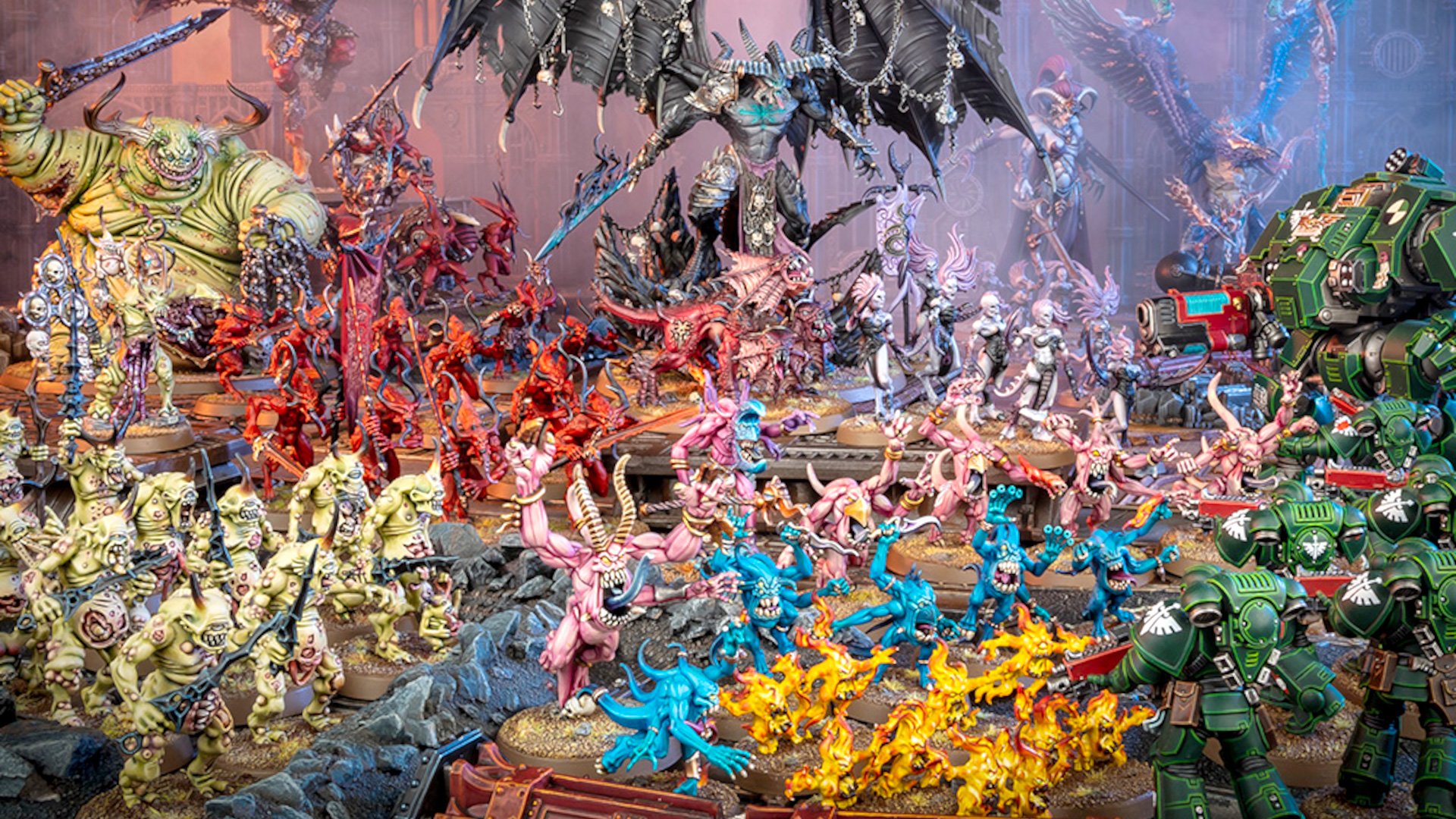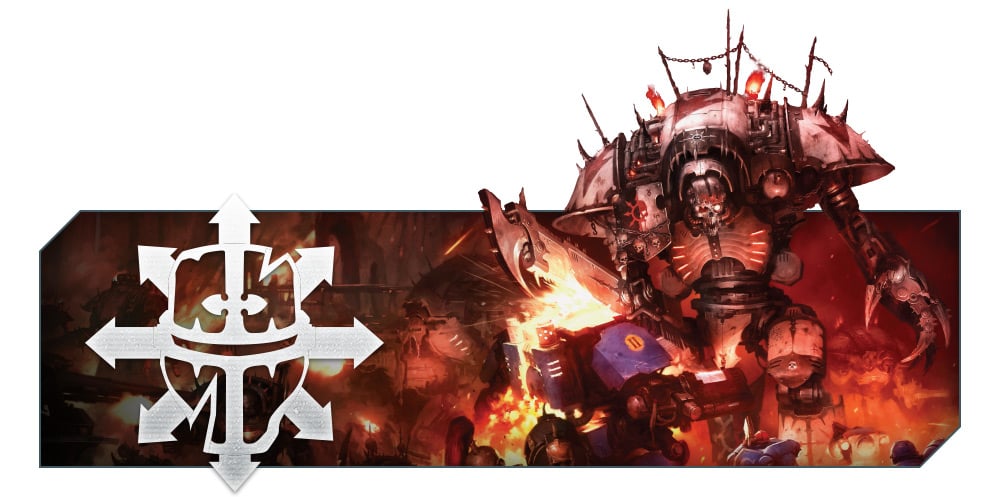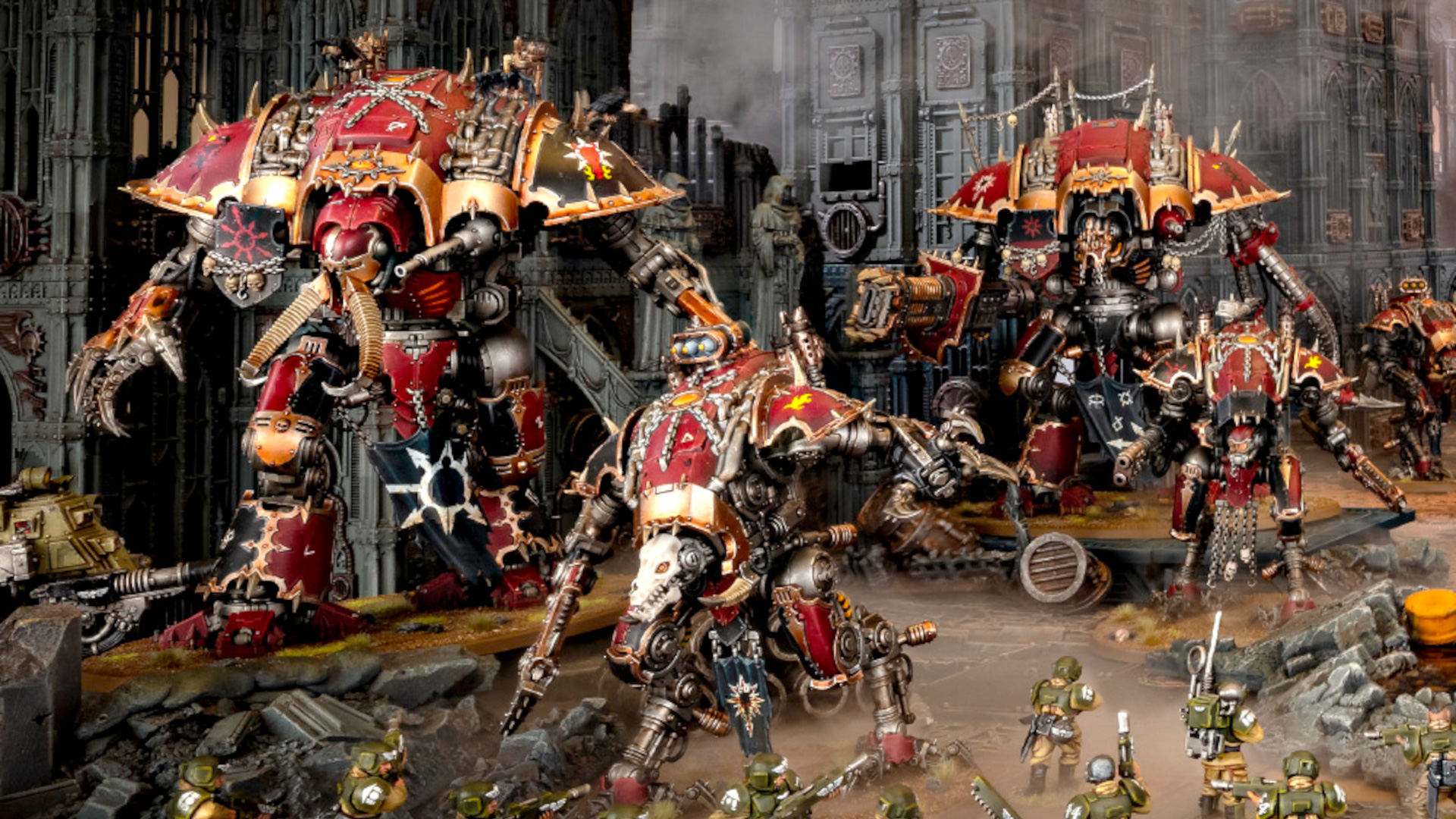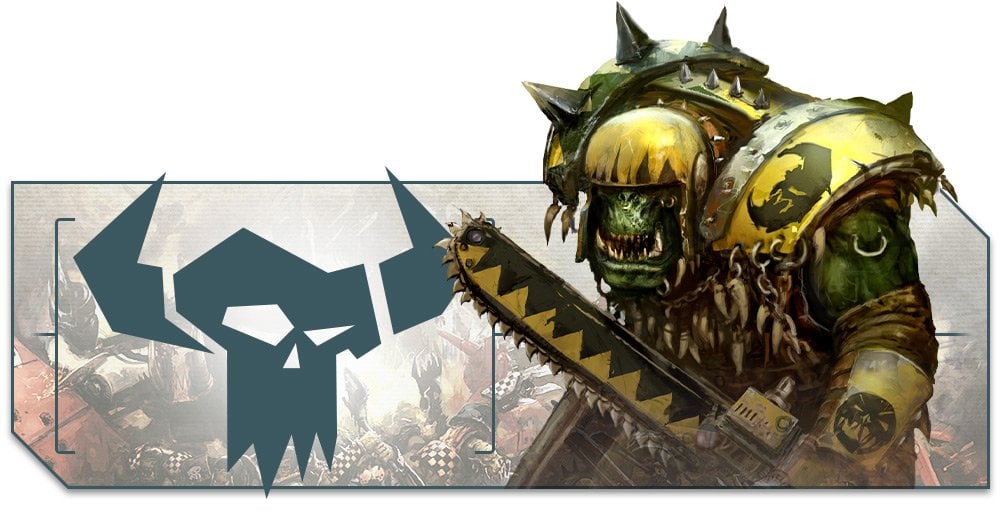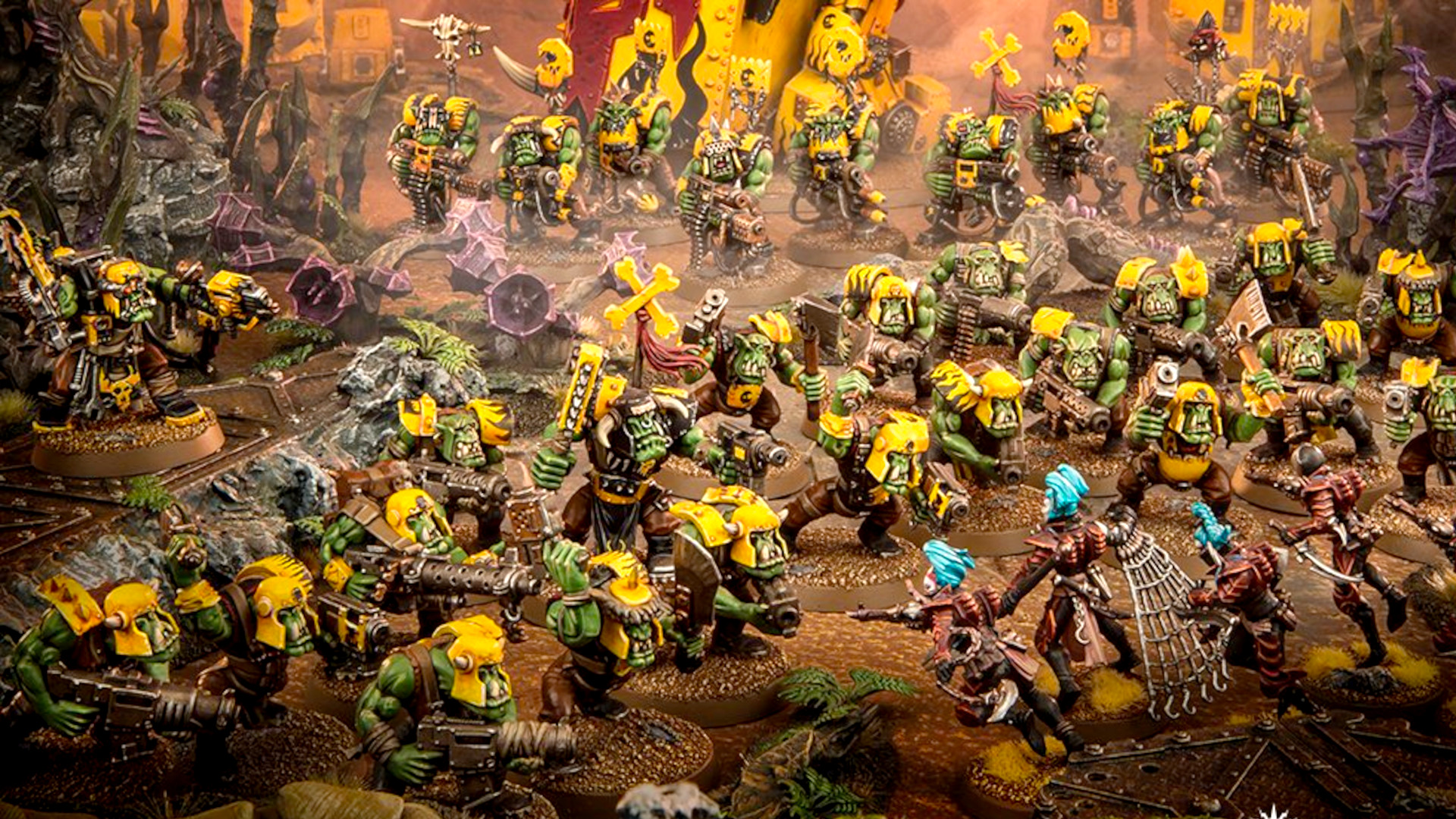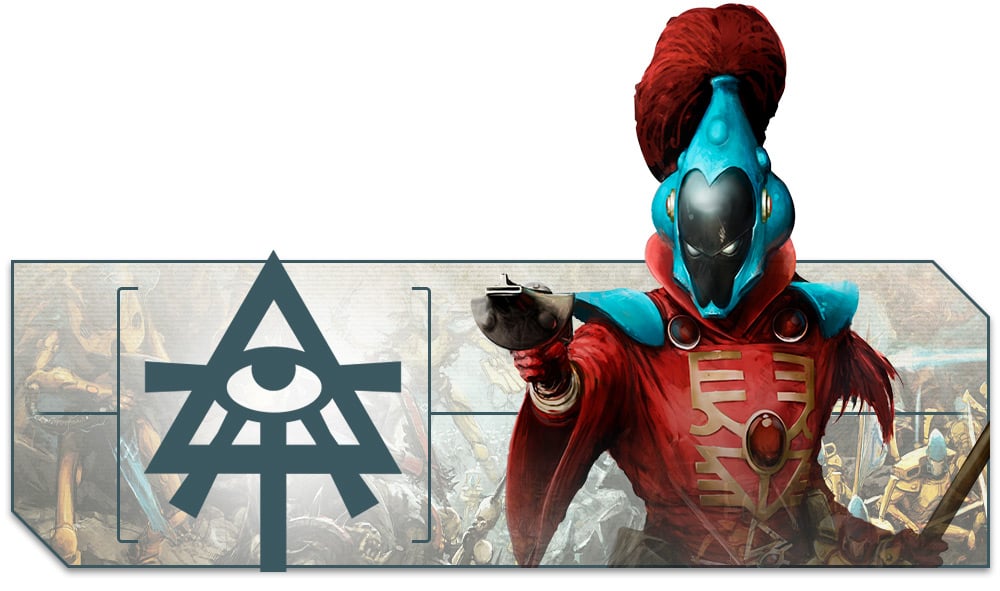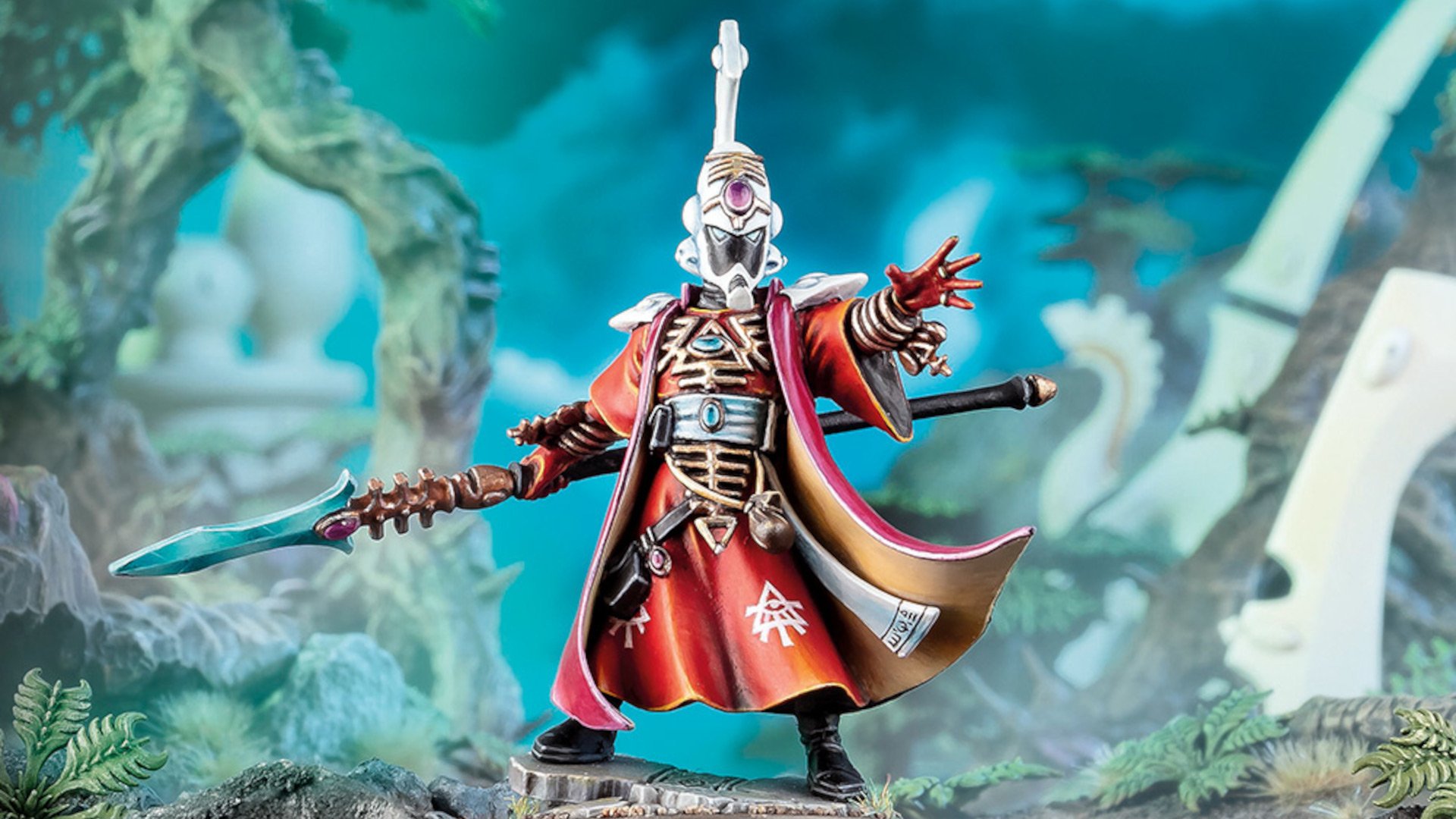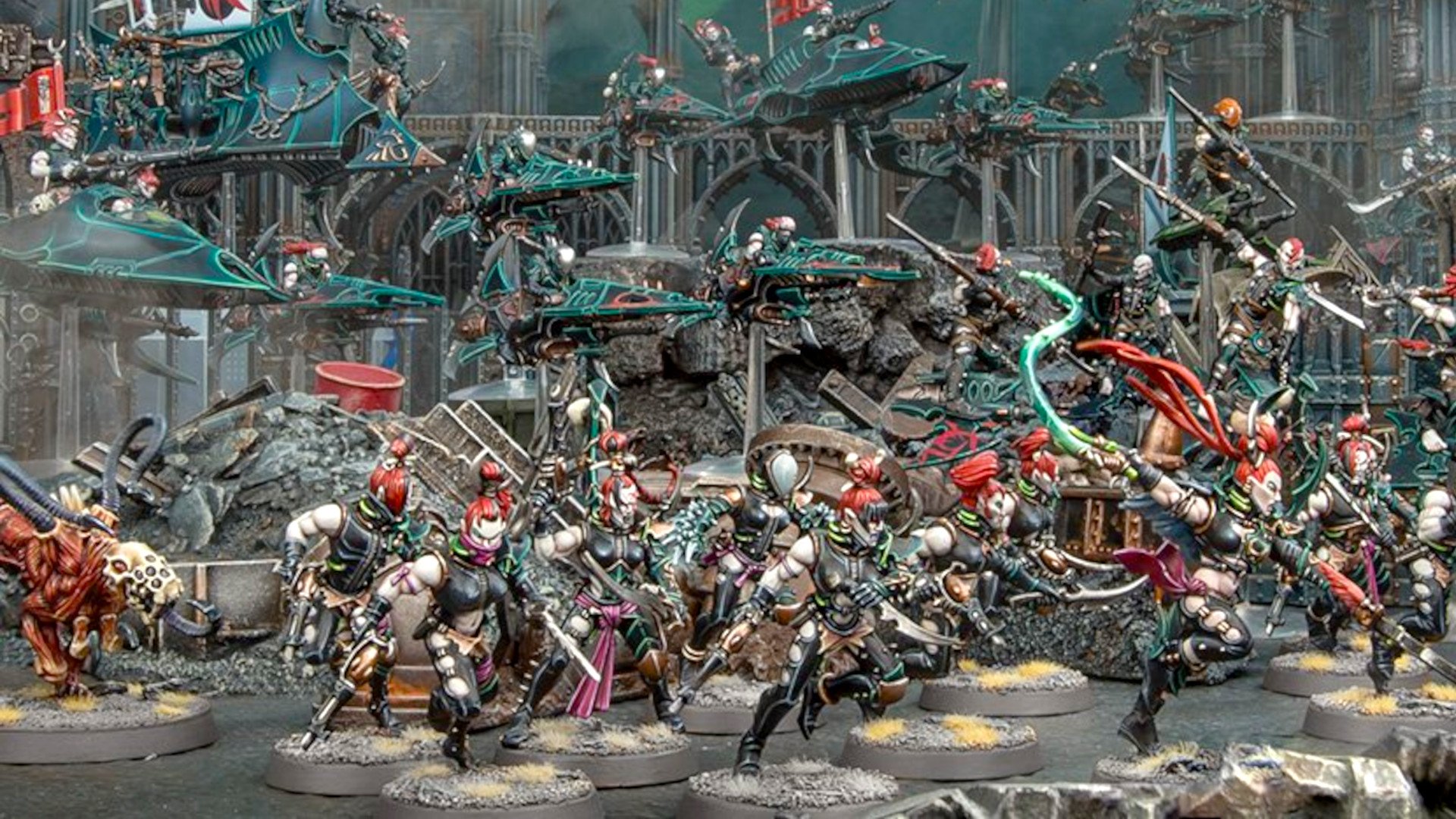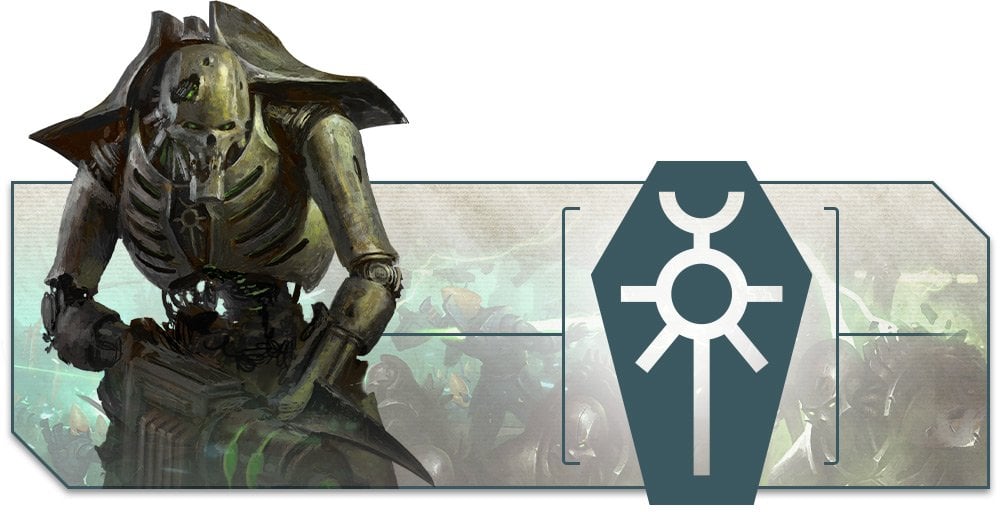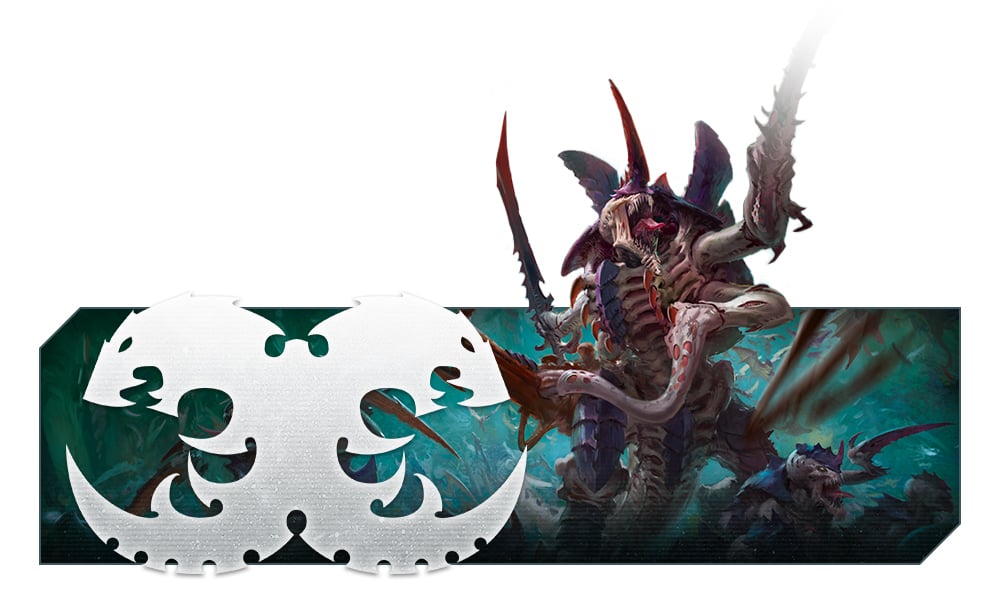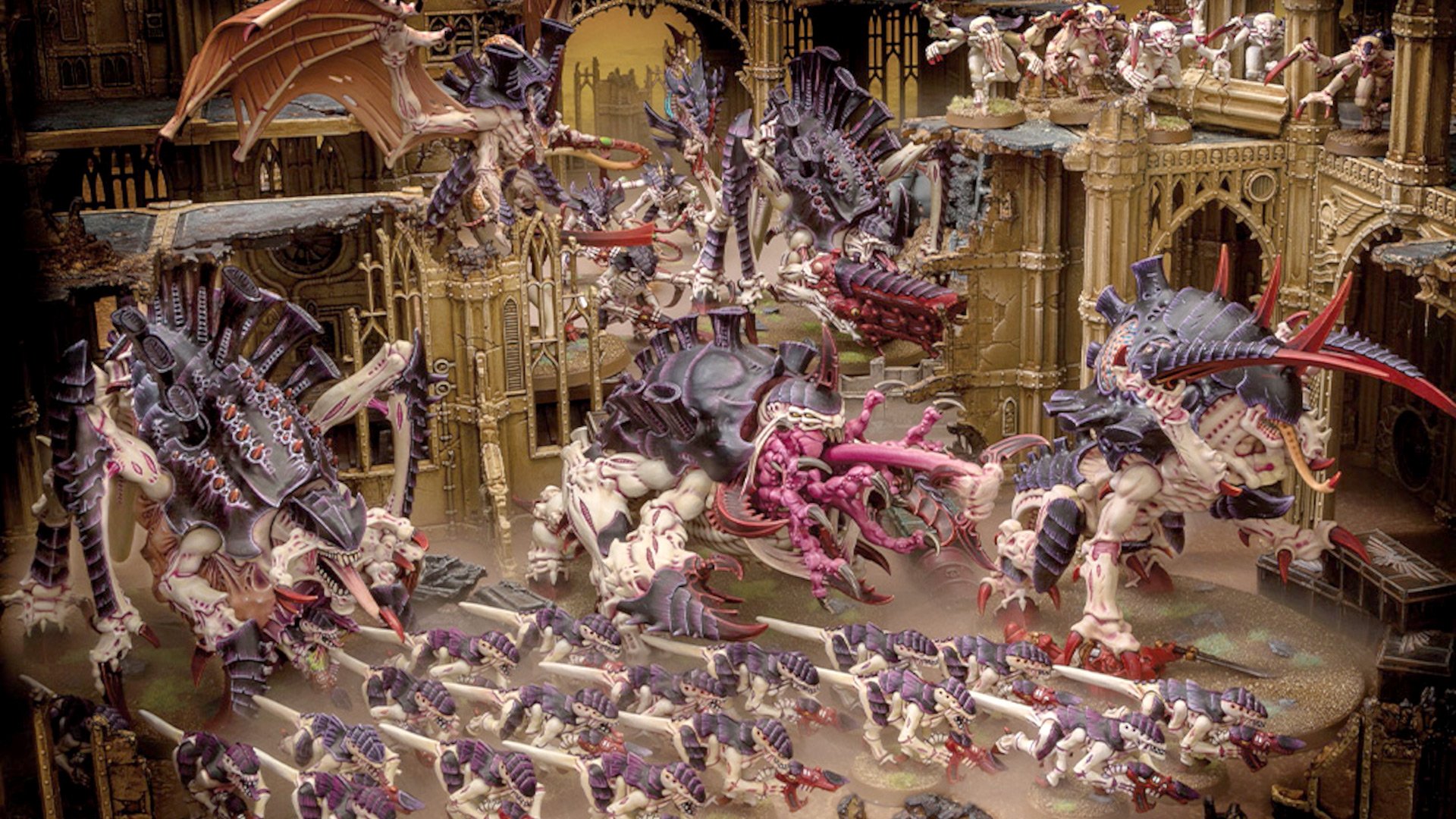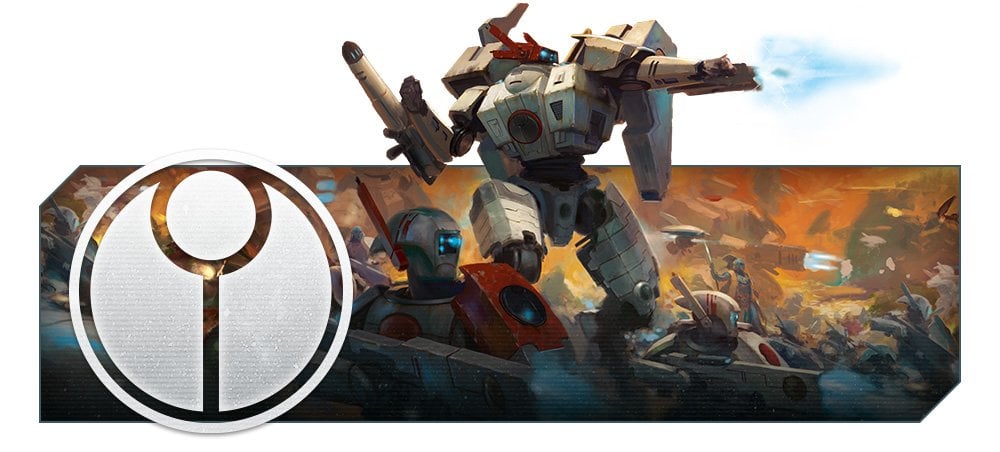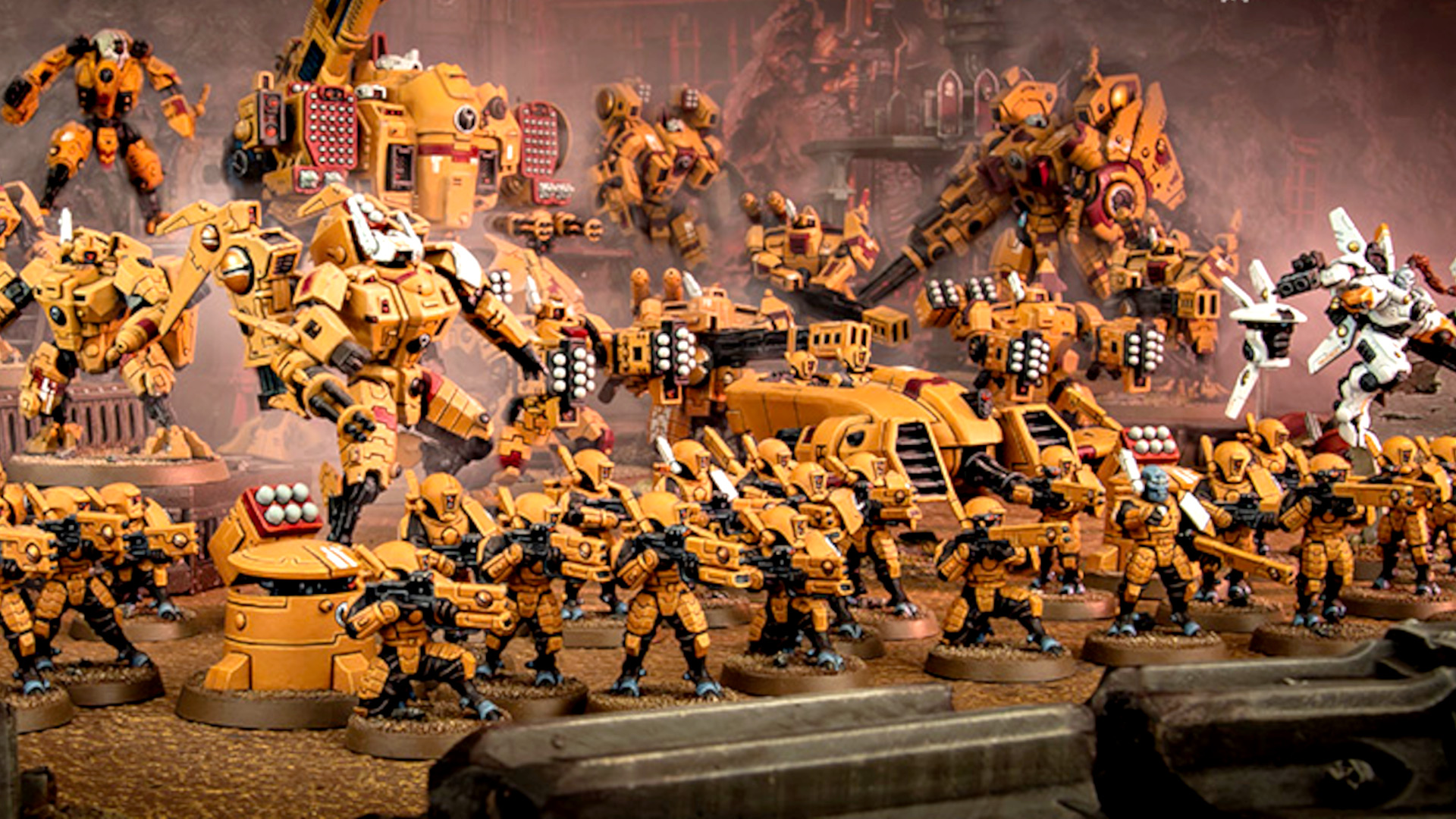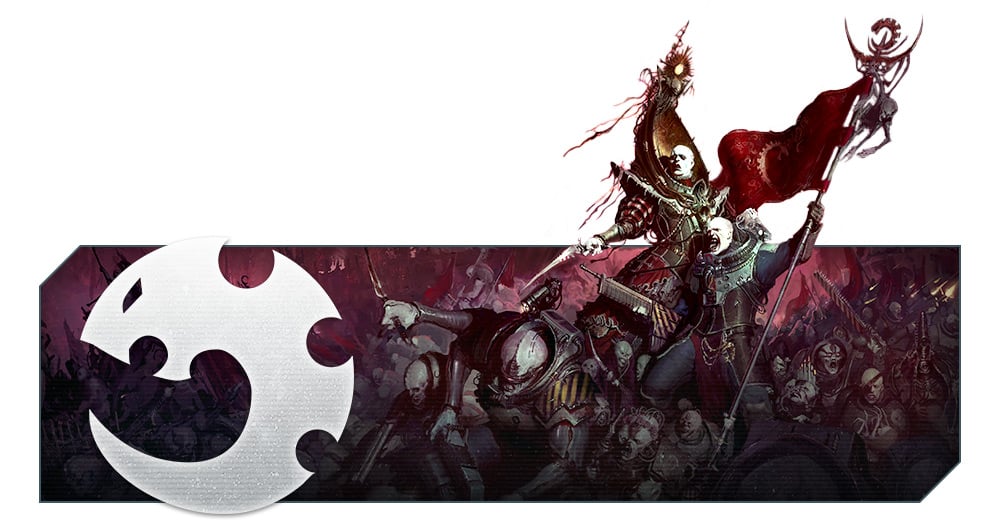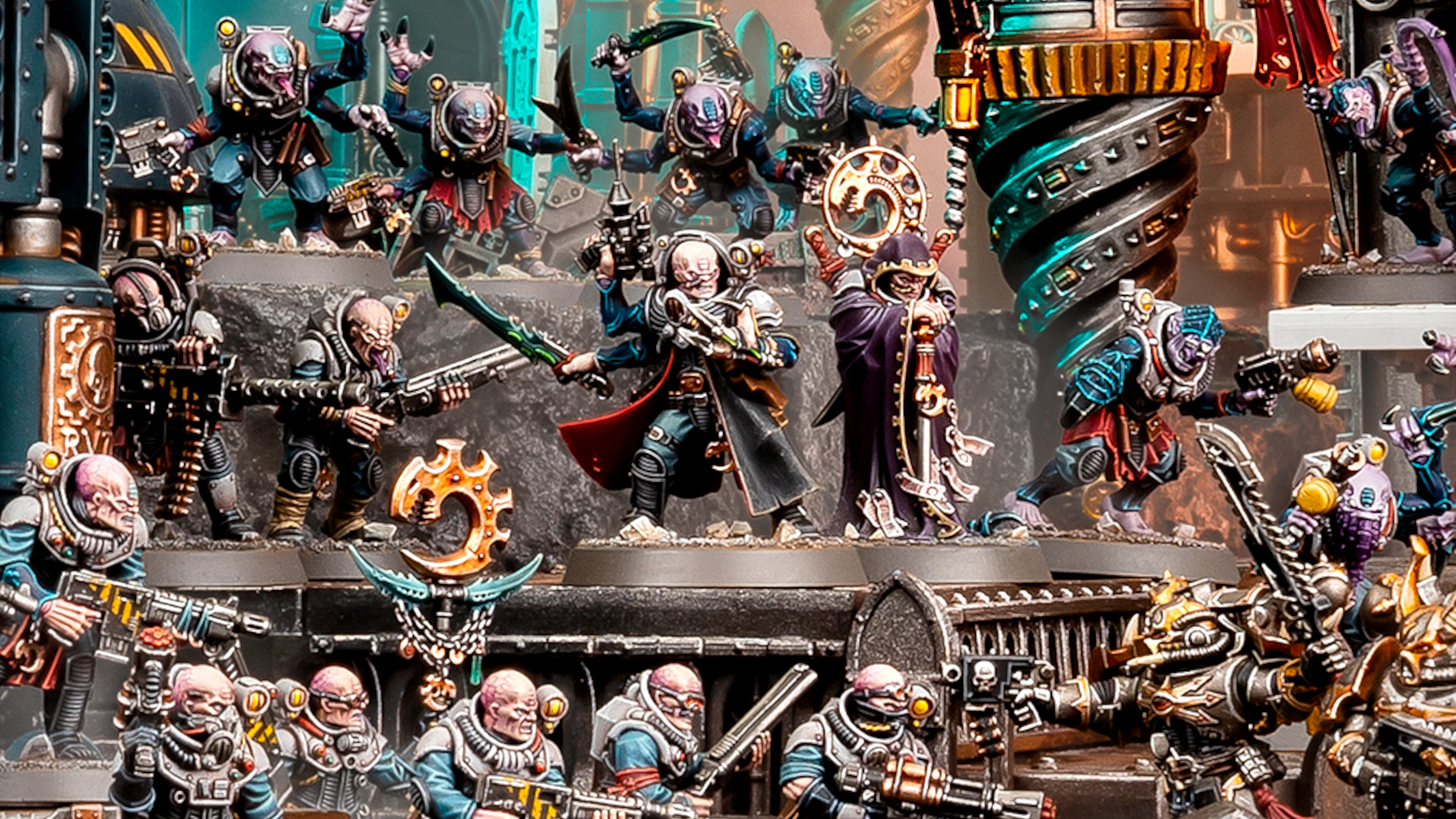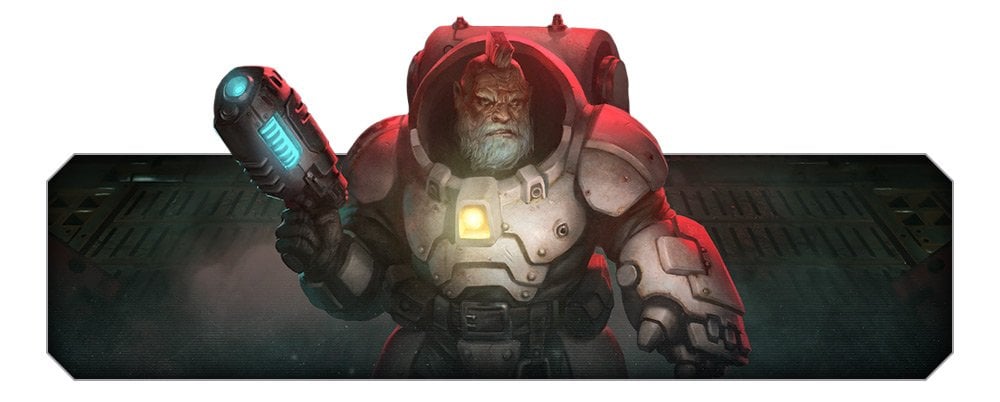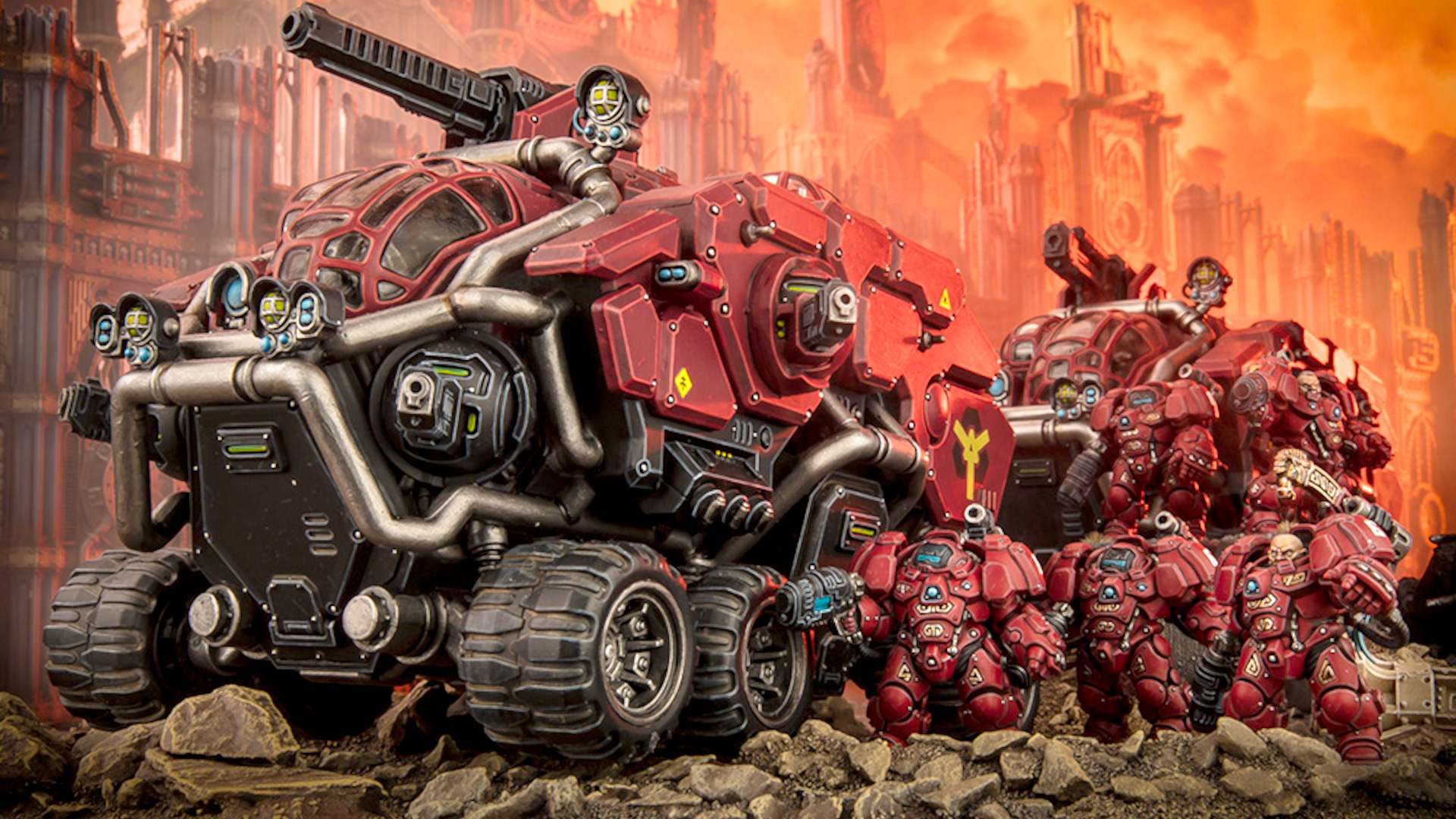To put things mildly, there are a lot of Warhammer 40k factions, races, and armies warring across the grimdark far future of Games Workshop’s flagship sci-fi wargame – 20 of them, to be exact. And that’s only counting the ‘main’ 40k armies – the ones that have their own fully fledged codex rulebook.
There are at least another 13 offshoot factions (mostly specialised Space Marine chapters) with their own models and rules supplements – but in this guide, we’ll focus on the 20 full-blown tabletop 40k armies, untangling 40k’s futuristic tribes to help you find the perfect one for you.

Before we kick off with this beginner’s guide to every single 40k faction, you should know: the many armies in Warhammer 40k are roughly divided into three groups: the Warhammer 40k Imperium of Man, the Warhammer 40k Chaos factions, and the galaxy’s various species of aliens – known as the Warhammer 40k Xenos factions.
These umbrella categories are important in learning how to play Warhammer 40k, as (outside of narrative game modes) you’ll normally find Imperium armies can only team up with other Imperials; Chaos with Chaos; and most Xenos rarely make common cause with anyone. To dive deeper into each ‘super-faction’, click those links above to read our detailed guides for each.
For a broader grounding in the game, you might also try our guide to every Warhammer 40k codex, our run-through of how Warhammer 40k detachments work, or our list of the Warhammer 40k combat patrol starter sets. If you just want a brief overview of each of the galaxy’s fighting forces, however, read on.
Here are all the current Warhammer 40k factions:
Sisters of Battle
The Sisters of Battle (a.k.a. Adepta Sororitas) are the militant wing of the ‘Ecclesiarchy’ – the Imperium’s galaxy-wide state religion, fiercely worshipping the Emperor of Mankind on his Golden Throne on Terra (40k’s far-future earth).
Their lore origins are rather amusing: due to a diktat that the Imperial Faith wasn’t allowed to have its own force of ‘men under arms’, it instead raised an all-female army of bloodthirsty zealots, armed them all with deadly weapons and power-armoured corsets, and unleashed them on the Emperor’s enemies.
On the 9th edition Warhammer 40k tabletop, the Sisters of Battle are a powerful, but high skill-level force that relies on overlapping buff aura abilities, stat-upgrading prayers, and careful manoeuvring for victory – though all that is aided by ‘Miracle Dice’ which allow you to store up useful dice results, and whip them out later in the game to get out of tight spots.
You can get a complete Adepta Sororitas lowdown in our full Sisters of Battle army guide.
Adeptus Custodes
The gold-armoured giants of the Adeptus Custodes are the personal bodyguard of the Emperor of Mankind – bigger, stronger, smarter, and deadlier versions of regular Space Marines, crafted directly from the Emperor’s own genes.
Originally there were 10,000 of them, but in the 41st millennium this elite force has been whittled down to just a few hundred. Luckily, each individual ‘Custodian’ is a fighting force unequalled by almost any other being in the galaxy – meaning you’ll quite often see a tabletop army of Adeptus Custodes that’s just a handful of miniatures strong.
Don’t be fooled by the numbers, though. With multiple layers of defensive saving throws, it’ll take your opponent a lot of firepower to take out each Custodian, and if the let you get close, the Custodes’ exceptional offensive abilities and unique weaponry will tear through pretty much anything on the table.
Incidentally, they’re also the favoured army of everyone’s favourite famous Warhammer 40k fan Henry Cavill – praise be!
To learn more about the Emperor’s golden boys, read our complete Adeptus Custodes army guide.
Adeptus Mechanicus
Originating on Mars and allied with the Imperium of Man, the Adeptus Mechanicus is a galaxy-spanning cult made up of technology-worshipping cyborgs, cybernetic ‘Servitor’ constructs, and legions of vast, ancient war machines (including the mighty Warhammer 40k Titans).
Led by a cadre of arcane Tech-priests (whose bodies are in various stages of conversion from flesh-sack to entirely synthetic metal and silicon avatar) the Adeptus Mechanicus maintains the Imperium’s galactic stocks of spaceships, tanks, aircraft, weapons, and armour. The AdMech’s own armies are made up of a mixture of cyborg Skitarii warriors, robotic battle automata, and high-tech war machines.
On the tabletop, AdMech armies tend to have an extra large helping of firepower, but their flesh-and-metal bodies (while no doubt very efficient) break easily under sustained fire or melee combat – so they’ll often want to shoot opponents off the board early. Those new to modelling and painting miniatures should also beware: these guys can be spindly and difficult to put together, with many nooks and crannies that are challenging to paint well.
For full details on the Imperium’s technological legions, check out our dedicated Adeptus Mechanicus army guide.
Astra Militarum
The Astra Militarum – also called Imperial Guard – is the Imperium’s standing army: a mind-bogglingly huge force of (mostly) human soldiers, tanks, and aircraft drawn from Imperial worlds all over the galaxy. They’re the first line of defence (and attack) in humanity’s never-ending war for survival and domination.
The Guard fight in gigantic formations of lightly-armed and -armoured infantry, massed artillery, and mass-produced tanks made as cheaply as possible from ancient blueprints nobody even understands any more. Wavering troops are kept in line by trigger-happy, Soviet-inspired ‘Commissars’ who, at critical points during games, can keep soldiers from running by shooting their own troops. Dark stuff.
On the tabletop, Guard armies customarily field bucketfuls of infantry squads, with company commanders expecting the vast majority to die before victory is achieved. Before that happens, though, there’s a lot of satisfying gameplay to be had in issuing various Orders to your units, setting them up for different tactical roles as you charge ahead. Remember, you can kill anything if you shoot enough lasguns at it.
To fully enlist in the Emperor’s human forces, dive into our complete Astra Militarum army guide.
Space Marines
The poster boys for both the Imperium and Warhammer 40k as a whole – you already know who the Space Marines are. Nine-foot-tall genetically enhanced super-soldiers, the Space Marines – a.k.a. Adeptus Astartes – march into battle in massive suits of power armour, adorned with the colours and heraldry of one of hundreds of proud ‘Chapters’.
The Emperor created the Space Marines over 10,000 years before the current 40k era, intending them to be his ultimate force to conquer the entire galaxy. That didn’t quite go to plan, but they’re now stronger than ever, reinforced with upgraded Primaris Space Marine variants, and they form the tip of the spear in all humanity’s wars, paving the way for the far more numerous Astra Militarum troops to land and do all the donkey work of conquest.
On the tabletop, Space Marines are generally known as the most accessible and forgiving faction to collect and play. Their rules are simple, they have lots of units to choose from, and they’re all relatively strong in both offensive and defensive roles. Plus, with hundreds of unique chapters to choose from, it’s easy to create an army with the lore and looks you want. Most new Warhammer 40k players start with Space Marines, and it’s easy to see why.
To properly induct yourself into the Adeptus Astartes, read our complete guide to Warhammer 40k Space Marines.
Grey Knights
The Grey Knights are a secret order of Space Marines based on Titan (Saturn’s largest moon) whose sole job is to hunt down and destroy the daemons of chaos. Specially selected as children from across the Imperium, every Grey Knight is a psyker, with a battery of psychic abilities for killing enemies, defending themselves, and banishing daemons back to hell (for more info, do check our full Grey Knights guide)
In tabletop Warhammer 40k, the Grey Knights are a visually striking force of bluish-silver marines, garbed with knightly accoutrements, heraldry, and various cool-looking anti-daemon doodads. Given their elite nature, you’ll be fighting with a smaller force than other armies – perhaps just a handful of Grey Knight Terminators and Paladins – but if you make clever use of their prodigious psychic abilities to keep your squads alive and make enemies dead, you’ll find them a deceptively deadly army.
If you’re set on joining the psychic Knights of Titan, check out our in-depth Grey Knights army guide.
Imperial Knights
Towering, two-legged war machines piloted by a single, highly trained aristocrat, the Imperial Knights are technically the most elite fighting force in the galaxy – purely because there are, at most, a few hundred of them left and nobody knows how to make any more.
Thudding into battle on massive metal legs, bedecked in preposterous amounts of chivalric heraldry, pennants, and emblems, the Imperial Knights are quite literally medieval knights, except riding 40-foot-high robot battlesuits instead of horses. Armed with a choice of weaponry, from super-powered long range lasers to massive, upsized versions of Space Marine chainswords, knights are simultaneously super-cool, and too ridiculous for words.
Although each full-size Questoris Knight model will set you back at least $170 / £105, this is actually one of the cheaper Warhammer 40k factions to collect – because you only need three to make up a full army. Since their basic strategy can be summarised as ‘walk forwards a bit and kill stuff’, they’re also one of the most beginner-friendly forces – though be warned: building and painting these big fellas is a longer term commitment than almost any other Warhammer model.
Want to start a knightly house of your own? Indulge yourself with our complete guide to the Imperial Knights army.
Chaos Space Marines
Forming the main bulk of the forces of Chaos, the fearsome Chaos Space Marines are the dark, spiky mirror image of their Imperial counterparts. Long story short, 10,000 years ago, the Emperor’s favourite son Horus Lupercal struck a deal with mysterious dark gods to kill his dad, and took half the Space Marine legions with him in a rebellion called the Horus Heresy.
He lost, and died – but many of his traitorous Space Marines escaped, and have spent the last ten millennia rebuilding their power and numbers, and intermittently warring with the Imperials in the name of their chaos gods. They’ve also become more and more touched by the Warp powers they allied with, gaining daemonic comrades, as well as weapons, armour, and war machines imbued with unnatural powers.
On the tabletop, Chaos Space Marines have a few different flavours and playstyles depending on which legion or sub-faction you belong to – but, in general, they play as a more aggressive and temperamental (but sometimes more powerful) version of regular Space Marines.
You’ll field core squads of Legionaries, backed up by Havoc gunners, jump pack-equipped Raptors, and swathes of human shields – er, Chaos Cultists, we mean. For the glory of the four in the Warp!
Ready to join the corrupt ranks of the Heretic Astartes? Check out our full Chaos Space Marines army guide for more info.
Death Guard
One of two standalone, specialised Chaos Space Marine armies, the Death Guard are a traitor Space Marine legion sworn to serve Nurgle, the chaos god of disease, decay, and entropy. During the Horus Heresy, primarch Mortarion, lord of the Death Guard, made a desperate bargain for his legion’s survival – but in the process doomed them all to eternal servitude to Nurgle.
In the 40k era, every last Death Guard Chaos Space Marine is a walking vector of the plague god’s disease, riddled with every infection imaginable and kept alive only by Nurgle’s otherworldly magic.
On the tabletop, they march into battle with squads of these Plague Marines, backed up with a coterie of revolting but powerful character models to provide buffs; foul, corroded daemon engines; and crowds of diseased zombies charmingly called Poxwalkers. And let’s not forget their ever-present daemon pets, the cute, frolicking Nurglings.
Excruciatingly hard to kill due to their Disgustingly Resilient special rule, Death Guard make for a tough, challenging opponent – and quite an accessible beginner army (if you don’t mind all the maggots and pus).
If Mortarion’s diseased legions appeal to you, better get truly infected by reading our complete Death Guard army guide.
Thousand Sons
The sorcerous Thousand Sons are the second traitor Space Marine legion to be made into their own independent army (soon to be joined by the Khorne-worshipping World Eaters). Aligned with Tzeentch, chaos god of change, fate, and deception, the Thousand Sons are all psykers – esoteric wizards driven by an insatiable desire for knowledge and deep understanding of the universe.
Though initially loyal to the Imperium, a series of tragic, well-intentioned mistakes by their primarch Magnus the Red during the Horus Heresy dragged the Thousand Sons into the clutches of chaos. Since then, they’ve pursued their own ineffable plots and quests across the galaxy, but always in opposition to the Emperor and his servants.
On the table, Thousand Sons armies centre on squads of Rubric Marines – empty suits of Space Marine power armour animated by chaos magic – supported by powerful chaos sorcerer marines, daemon engines, chaos animal-human mutants called Tzaangor, and – of course – daemons of Tzeentch. They’re a high skill level force to command, but play their psychic spells right and you’ll be smiting enemies off the table left, right, and centre.
Itching to be inducted into the mysteries of the Warp? Learn the sorcerous ropes with our full Thousand Sons army guide.
Chaos Daemons
Abominations spawned from the Warp (Warhammer 40k’s ever-present, terrifying parallel dimension) Chaos Daemons are a diverse horde of bizarrely-shaped, multi-coloured creatures that are technically just protrusions into our universe of the Warp’s ethereal forces. They’re entities formed by the will of the four chaos gods – Khorne, Nurgle, Tzeentch, and Slaanesh – with the objective of wreaking havoc in the real world.
Chaos Daemons can fight as allies to the Heretic Astartes, but they’re an army in their own right – with flexible rules that allow you to create forces allied to any one of the four gods, or a mixture of more than one. Each god commands a range of lesser daemons – small, large, fast, slow, some winged, some riding giant snails – and highly dangerous greater daemons like Nurgle’s Great Unclean Ones.
As befits this bewildering diversity, Chaos Daemons armies can function in all kinds of ways on the tabletop battlefield – but pretty much all rely on close-range combat to get their killing done; whether it be via Slaanesh’s impossibly fast Daemonettes, the furious melee attacks of Khorne Bloodletters, or Nurgle’s Plaguebearers and their infuriating unwillingness to take damage.
Chaos Knights
Just as the Adeptus Astartes have their traitor counterparts, the Chaos Knights are the heretical mirror of Imperial Knights: these are the mech-warriors from the Knightly Houses who sided with the warmaster Horus Lupercal during the Horus Heresy, and never looked back (plus a few others who turned to chaos in the following ten thousand years).
Piloting largely the same models of walking war machine as the loyalists, and wielding similar weapons, the Chaos Knights are set apart mainly by the Warp-touched details in their armour and equipment, and by their more sinister livery and decorations (think skulls, chains, and screaming faces replacing colourful flags and emblems). They have different unit names, too – with beast-faced War Dogs taking the place of Imperial Armiger-class knights, for example.
On the tabletop, too, Chaos Knights play similarly to the Imperials in many ways – you’ll still be mainly walking forward a bit onto key objectives, shooting a lot, and bashing anyone that tries to mob you. Their main unique mechanic is Harbingers of Dread, which applies stacking debuffs to nearby enemies that get worse and worse throughout the game – representing the fear Chaos Knights strike into enemies. Well, they are pretty terrifying.
Want to command your own lance of fear-inducing hell robots? Get the full lowdown in our complete Chaos Knights army guide.
Orks
The Orks are an interesting contradiction of a Warhammer 40k faction: they are at once a truly scary, unstoppable force of pure, unfettered destruction – and the primary source of comic relief in an otherwise increasingly dour, serious sci-fi setting.
Massive, muscled, green aliens with huge teeth, axes, guns, and egos, the Orks are a race that lives exclusively to do three things: fight, fight, and reproduce (which they do primarily by fighting). You see, the Orks breed by taking over planets by force and seeding them with their fungal spores, which grow into more Orks, which spread to more planets, and so on.
In the main, Orks don’t actually want anything, except more fighting, and – though they’re easily outsmarted or outmanoeuvred individually – they’re devastating in large numbers, and multiply incredibly quickly. As a result, they’re an implacable and almost invincible foe to the other races of the galaxy.
On the tabletop, Orks are one of the classic Warhammer 40k armies – an unstoppable green tide of lowly, axe-wielding Boyz, backed up by squadrons of ramshackle, scrap-built vehicles; crowds of impish little Grots; and, of course, mighty Warbosses (who lead their armies by dint of being bigger and stronger). Collecting and playing Orks takes time and commitment (you’ll have a LOT of Boyz to paint) but it’s an ever popular army, with much joy to be found in roaring “Waaagh!” across the table.
For all the info needed to become Big Boss of your own apocalyptic Green Tide, check out our complete Orks army guide.
Aeldari
The Aeldari (previously known as Eldar) are – let’s not beat around the bush – space elves. Tall and willowy; long-lived and wise; pointy-eared and full of poise; proud guardians of a once great but now shrivelled empire – they are a direct sci-fi analog of the Eldar in J.R.R. Tolkien’s Lord of the Rings.
That’s not to say they’re not a deep and compelling Warhammer 40k faction, though; the collapse of their erstwhile empire was so cataclysmic, it gave birth to the chaos god Slaanesh, and that’s just the tip of the Eldar lore iceberg.
In the 40k era, the Aeldari are splintered into various tribes, the largest being the Craftworld Eldar, who live on colossal, spacefaring civilisation-ships that house not only the living, but crystals holding the souls of all their dead. While their numbers are a tiny fraction of what they were, the Craftworld Aeldari can still field mighty warhosts, made up of both living warriors and war machines piloted by the sentient, crystal-bound souls of the dead.
On the tabletop, these warhosts fight very differently depending on their Craftworld – from the speed-obsessed Windrider Jetbikes of Saim-Hann to the powerful psychic Farseers and Warlocks of Ulthwé. Aeldari are slightly built and mostly lightly armoured, so your units will always be somewhat vulnerable – but they make up for it with powerful wargear and force-multiplying abilities.
Raising a noble Aeldari warhost of your own is a glorious undertaking – get all the guidance you need in our full Eldar army guide.
Drukhari
Depraved, sadistic raiders, slavers, and torturers, the Drukhari (previously known as Dark Eldar) fled the destruction of the ancient Aeldari empire, and, ironically, survived by building a culture based on the very dark perversions that brought the Eldar to ruin in the first place. They closely resemble their Aeldari cousins, but tend to wear darker, spikier clothes and armour, as befits their sinister nature.
Drukhari can only sustain their souls (and thus survive) by directly feeding off the pain and suffering of others; they literally live off torturing people. As a result, they are a civilisation that runs on a steady diet of slaves, taken in constant piratical raids on anyone and everyone they can reach from their hidden city of Commorragh.
On the tabletop, the Drukhari are one of the fastest Warhammer 40k armies around, usually relying on their nippy flying gunboats to get right into the fight as soon as the game begins. These then throw open the hatches, disgorging squads of Kabalite Warriors to lay covering fire with their needle rifles, and packs of drug-fuelled Wyches to carve enemies up in close combat. When necessary, these shock troops get backup from the horrific flesh-constructs of the Haemonculus Covens: patchwork warriors sewn together from bits of various unfortunate test subjects.
If you can’t wait to launch bloodthirsty raiding parties of your own, read our complete Drukhari army guide for more info.
Necrons
The ancient Egypt-inspired Necrons are technically both the oldest and most powerful of the Warhammer 40k factions. A race of cybernetic beings encased in immortal bodies of self-repairing living metal, their empire once controlled every inch of the galaxy with an iron fist (literally). After their undying robotic legions conquered every other power with ease, however, the Necrons eventually became bored of unchallenged dominion, and put their entire civilisation to sleep in AI-controlled stasis crypts.
Millennia later, in the 40k era, the all-powerful Necron dynasties are waking back up, and they are awfully cranky about all the upstart races that have taken over all their territory.
Billions of soulless Necron warriors (along with their royal leaders and swathes of Canoptek machine servants) are reawakening from stasis all over the galaxy and taking back their old worlds by force. Most recently, Szarekh the Silent King, supreme ruler of all Necrons, has returned to lead them.
In games of Warhammer 40k, Necrons are a slow but resilient force, and, while most of their weapons are limited to short range, once they get up close they’ll blast most targets to atoms with little effort. Keep your royal Overlords protected, and make good use of the Reanimation Protocols rule to revive your lowly Necron Warriors whenever they fall, and your living metal legions will reliably frustrate and destroy your opponents.
Your legions awake; a thousand Tomb Worlds full of metal soldiers await your command – read our full Necrons army guide to get started.
Tyranids
The Tyranids are the great unknown among the Warhammer 40k factions – known as the Great Devourer, these scythe-limbed insectoid monsters only want one thing: to feast on every single living creature in the galaxy, until nothing remains. Encroaching from the great black beyond the galaxy’s edge, the Tyranid Hive Fleets are creeping further and further across it, consuming biomass and breeding as they go.
Made up of a huge diversity of different bio-forms, from swarms of tiny Rippers up to mountain-sized Hierophant Bio-Titans, Tyranids seed planets with their spore pods before raining down numberless hordes of warrior beasts to engulf, overwhelm, and devour whatever life called those places home. They cannot be negotiated with, and – so it seems – cannot be stopped, only slowed in their advance.
Tabletop Tyranids armies can be made up of just a few big monsters – but more usually you’ll see Tyranid players field larger hordes made up of up to a hundred (or more) deadly bugs, including swarms of organic gun-toting Termagants and razor-armed Hormagaunts, raving packs of four-armed Genestealers, and hulking Tyranid Warriors. Their one weakness? Tyranids rely on their Hive Mind – and its Synapse links – for their greatest strengths; separate the swarm from its leaders, and the rest of the bugs are much easier to squash.
Want to consume the entire galaxy at the head of a murderous Hive Fleet of your own? Read our complete Tyranids army guide to find out how.
T’au Empire
The T’au Empire is a growing conglomerate of alien species united by an idealistic vision of galactic expansion through diplomacy. One of the youngest Warhammer 40k races, the slender, blue-skinned T’au – led by their rigid ruling caste of Ethereals – are unusual, in that they don’t always default to achieving their goals through warfare. That said, the Empire’s ethos of peaceful expansionism is always backed up by the threat of war, made manifest in its warlike fire caste and their armoury of devastating, high-tech guns.
What the T’au lack in numbers and territory, they more than make up for in martial skill and superior weapons tech; a small force of pulse rifle-armed T’au Fire Warriors, advanced Crisis Battlesuits, and Stealth-suit infiltration squads can often outgun far larger opponents with ease. If a world doesn’t want to join the T’au’s utopian project freely, it will usually be persuaded otherwise with overwhelming force.
On the Warhammer 40k tabletop, T’au armies have traditionally been a static gun line – you mass your troops in a defensive position, sit back, and shoot your long-range weapons at the enemy until either you win, or they close with your lines and you’re cut into little blue pieces. Since their 9th edition codex came out, though, the army has many more viable close combat options, and a wider variety of T’au army lists have appeared since. If you like flexible strategy, high-tech mech suits, big guns, and anime, this is the 40k faction for you.
Genestealer Cults
One of the newest Warhammer 40k factions on the block, the Genestealer Cults are an army of genetic bodysnatchers, insidious outriders of the Tyranid Hive Fleets. Most members of this faction look like normal humans – workers, miners, farmers, guards – but are in fact alien hybrids, slowly infecting the population on behalf of their unseen Tyranid masters.
You see, Tyranid Genestealers sneak onto inhabited planets and implant their DNA into living subjects – whose offspring then, over several generations, mutate into Genestealers themselves. Once enough people have been converted, they form underground cults that worship the ‘star children’ and begin to foment unrest and destabilise the planet – softening it up for the coming Tyranid invasion.
As a tabletop Warhammer 40k army, Genestealer Cults are the ultimate ambush force, making use of unique rules to hide which units they have deployed where on the board – only to be revealed when the trap is ready to spring.
In keeping with their theme of being a covert force embedded as ordinary workers, the Cults’ basic troops are lightly armed and armoured, not much threat on their own. Those who are in the more Genestealer-y stages of mutation can pose more of a threat, however – and fully transformed Purestrain Genestealers are just as deadly as their full-on Tyranid cousins.
The Cults can be a very tricky army to work, and, if your plans don’t come off right, you can be wiped out very quickly. But pull off a perfect ambush, and your inhuman warriors will pair with the considerable destructive power of heavy mining equipment to pulverise your foes.
Raise the flag of revolution and claim whole planets in the Star Children’s name with our complete Genestealer Cults army guide.
Leagues of Votann
The newest Warhammer 40k faction – released by Games Workshop in September 2022 – the Leagues of Votann are a reimagining of the original Squats (space dwarfs) from Warhammer 40k Rogue Trader, the game’s 1987 first edition. Given a heavy dose of grimdark seriousness to dilute the original Squats’ beardy silliness, these stout, sour-tempered warriors are highly dangerous, packing some of the galaxy’s deadliest weapons. So powerful were they, in fact, that GW nerfed the faction before it had even properly released.
The Leagues of Votann – who call themselves ‘The Kin’ – live in the perilous galactic core region, routinely avoided by the other 40k races due to its many dangers to ships passing through. A clone race, they closely guard the technological secrets of their survival, and – though they did originally come from Terra – have no love for humanity or its Imperium.
They mainly spend their time mining stars and planets for rare ore, and trading with other races whenever they can see profit in it. Though not inherently warlike, the Kin see any valuable territory or materials as rightfully theirs for the taking, and don’t hesitate to blast anyone who’ll stand between them and a profitable mining prospect. True space dwarfs indeed.
In games of Warhammer 40k, the Leagues of Votann function a lot like Space Marines. They’re tough to kill thanks to their Void Armour, which reduces the armour piercing power of incoming shots; their less-armoured basic Hearthkyn warriors and turtle-shelled Einhyr Hearthguard elites can flex into various roles thanks to a good choice of potent guns; and they’ve got very solid vehicles to ferry troops around, providing withering heavy weapons fire. Meanwhile, their unique, armour-melting Beam weapons can hit and wound multiple targets at a time, dominating battlefields.
The Eye of the Ancestors rule is the jewel in their dwarven crown – every time an enemy unit kills one of your units, completes an action, or claims an objective on the board, your whole army gets a better and better chance to automatically wound that target whenever they hit it – meaning your opponent’s most vital point-scoring units swiftly become their most vulnerable.
It remains to be seen if these grudge-bearing geezers will catch the wrong end of GW’s nerf bat a second time – but for now they’re among the most powerful Warhammer 40k factions out there.
For full details on the Kin and their galaxy-beating armoury, check out our complete Leagues of Votann army guide.
Source: Wargamer



